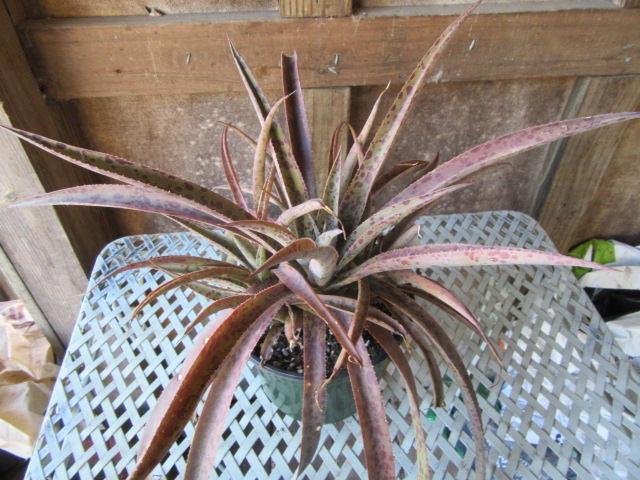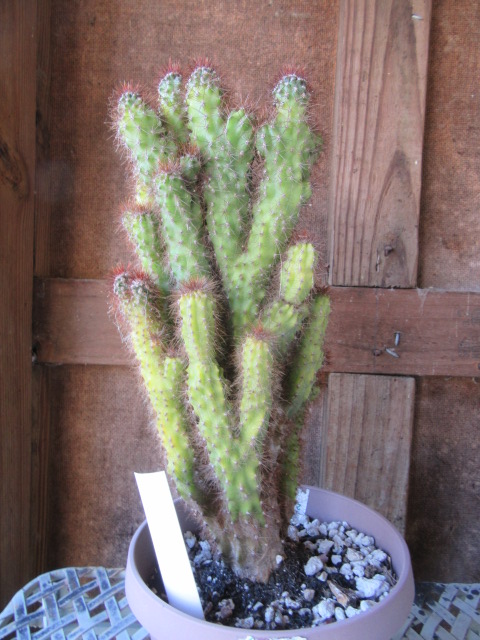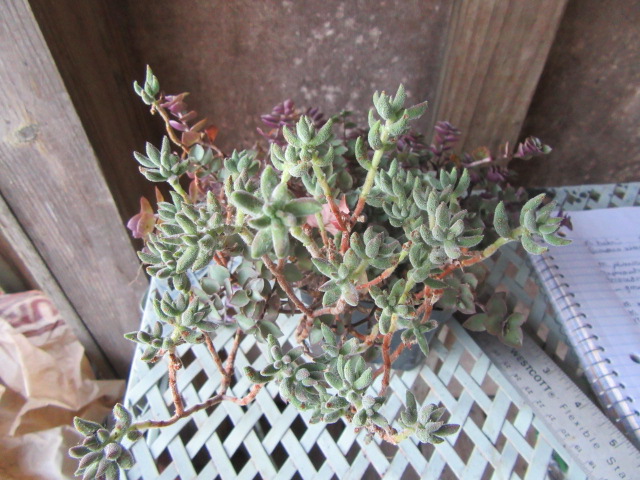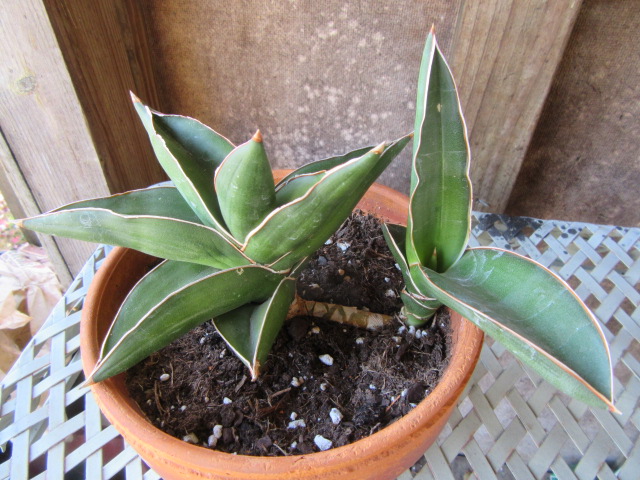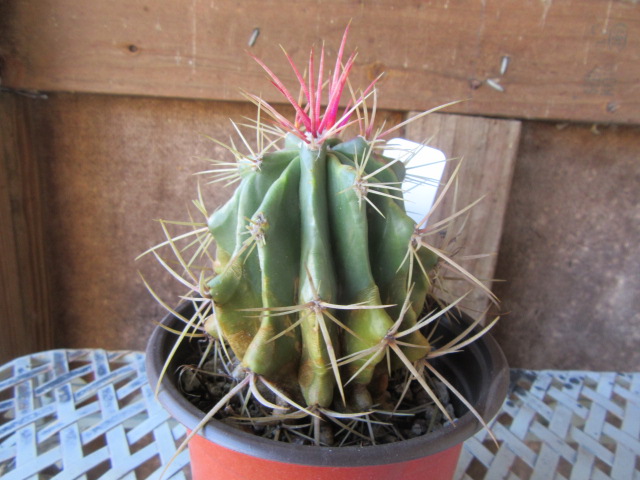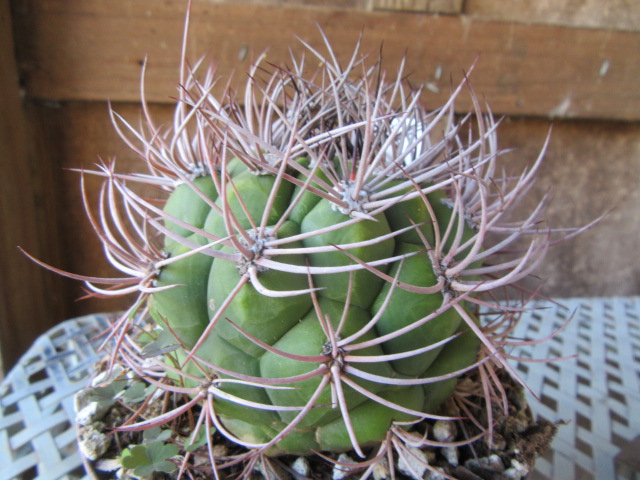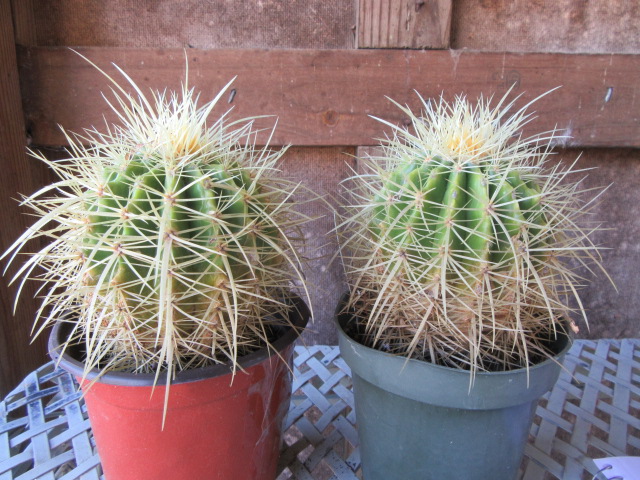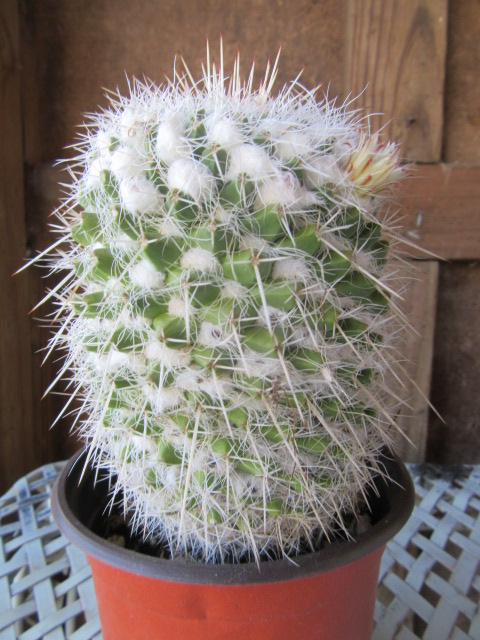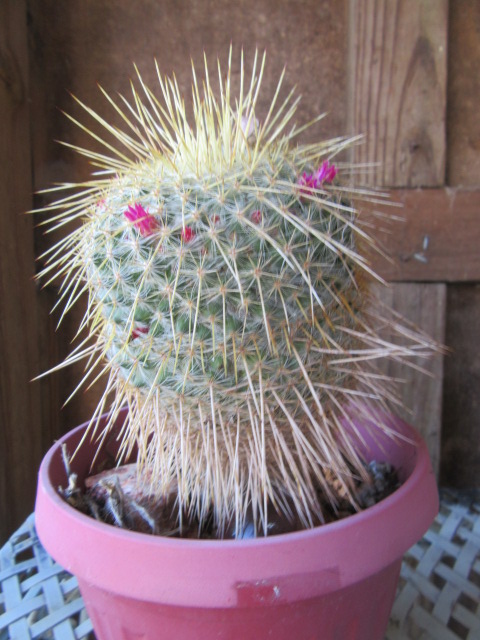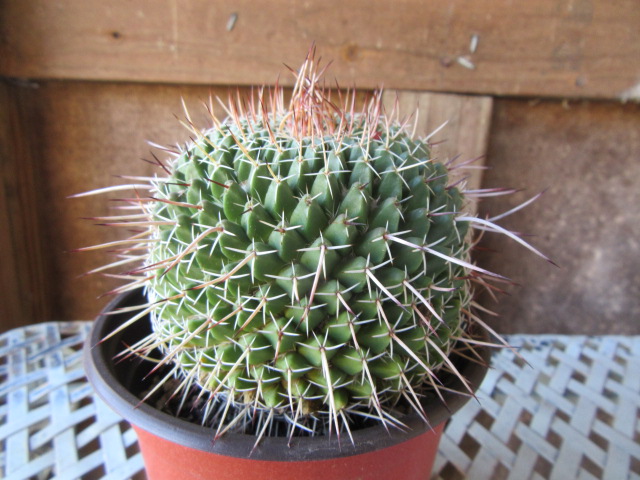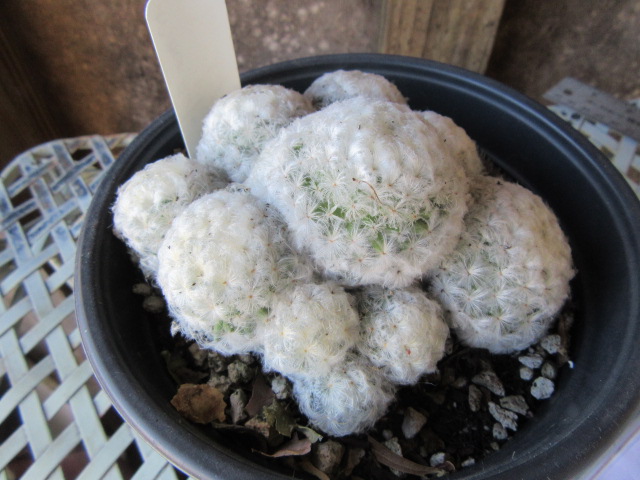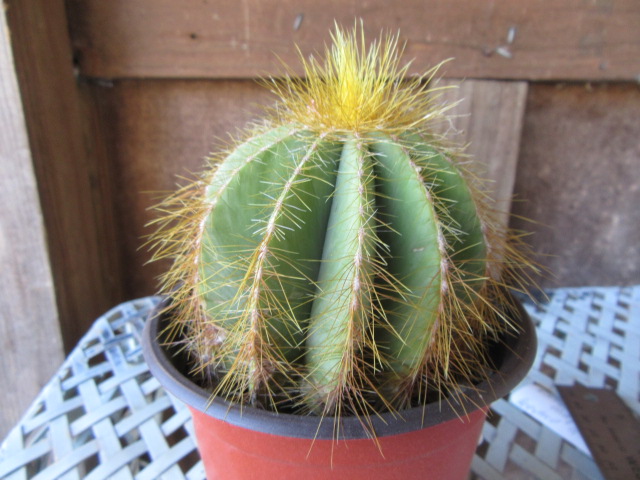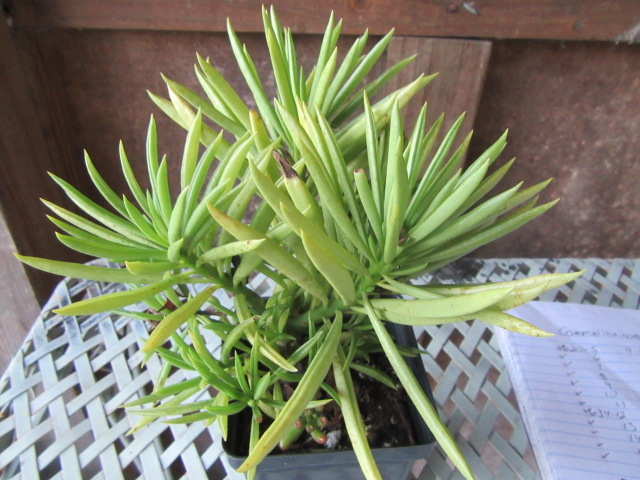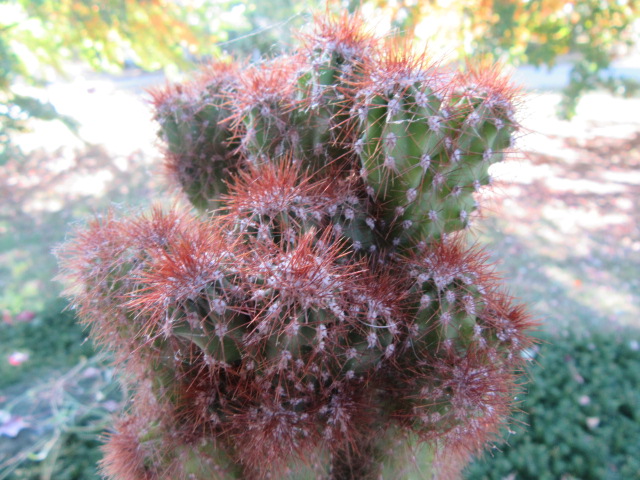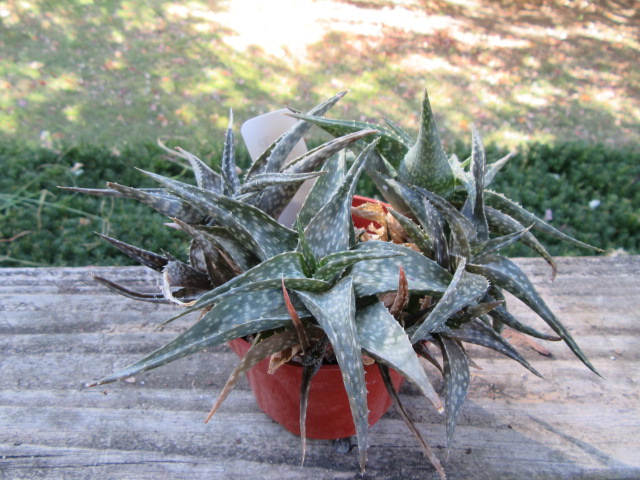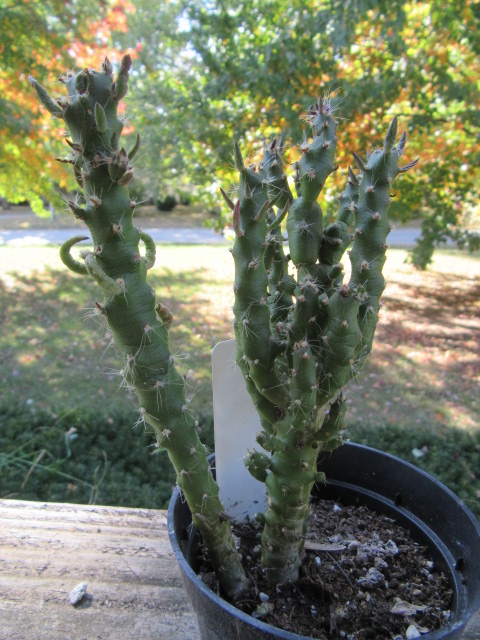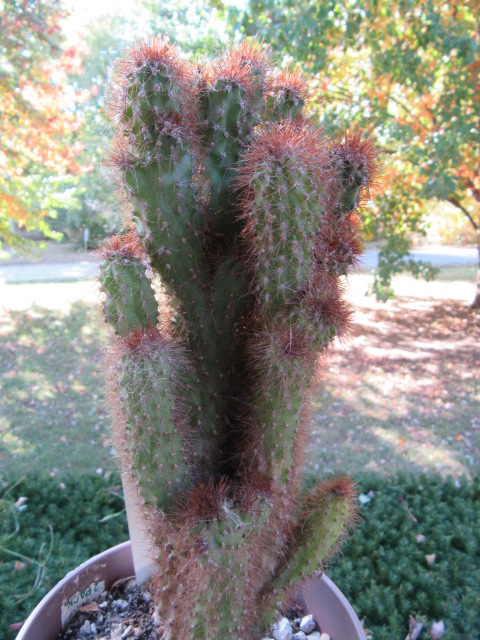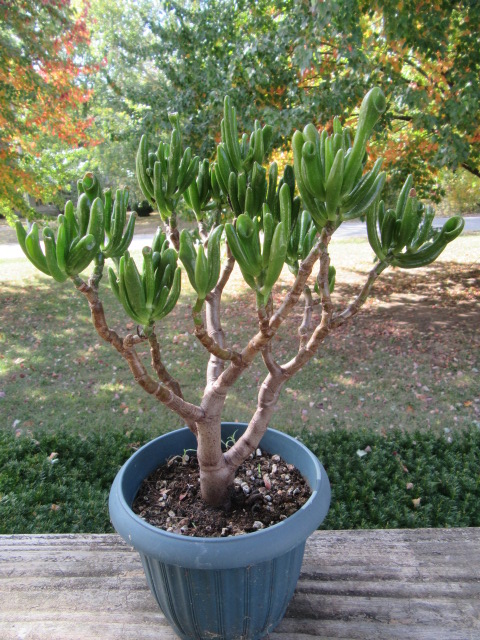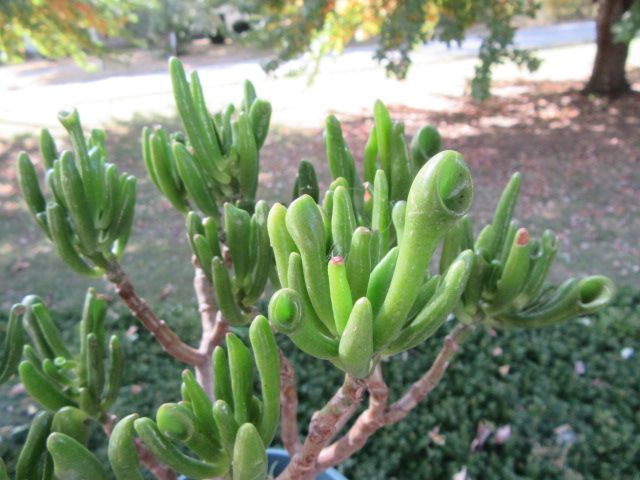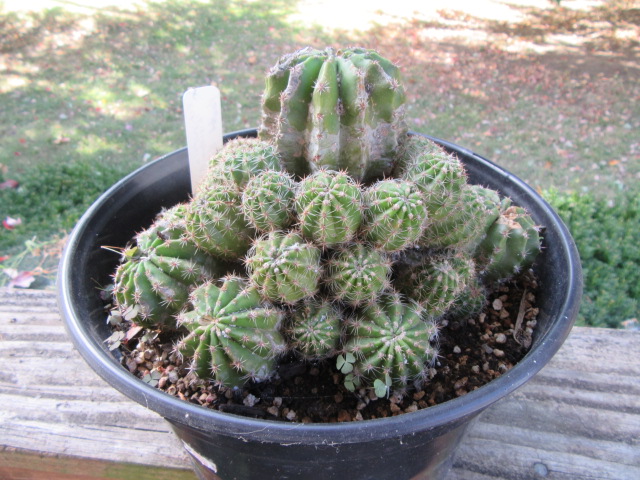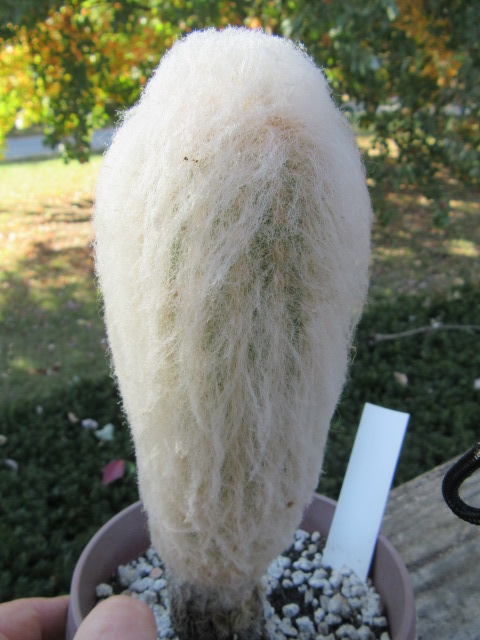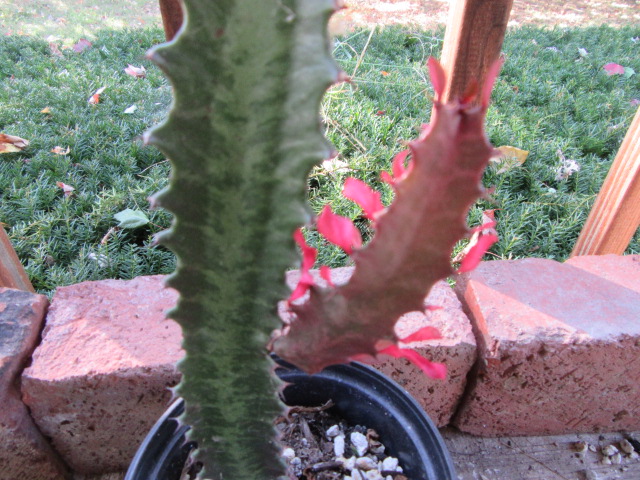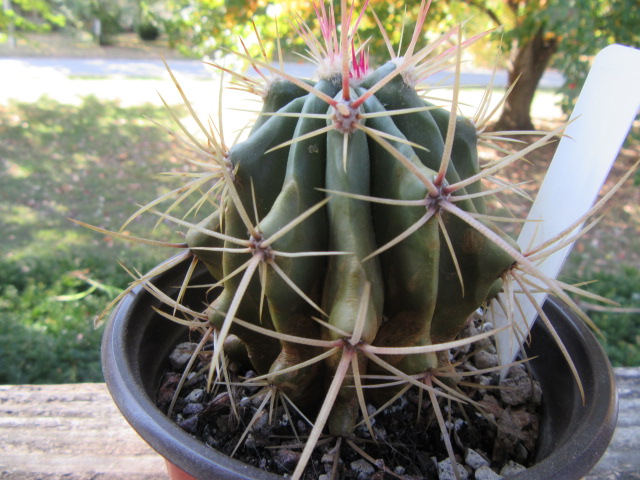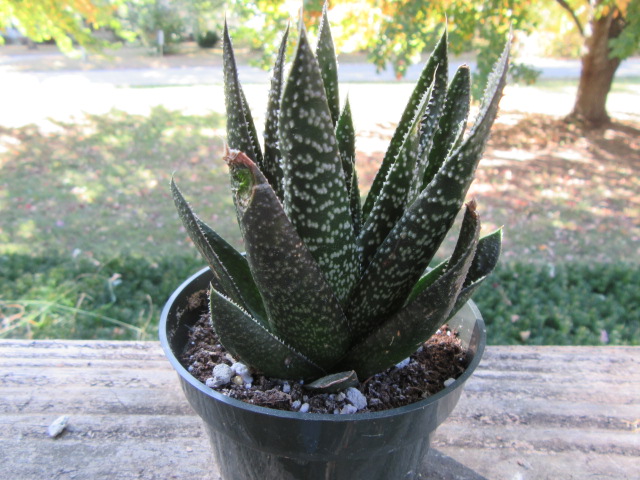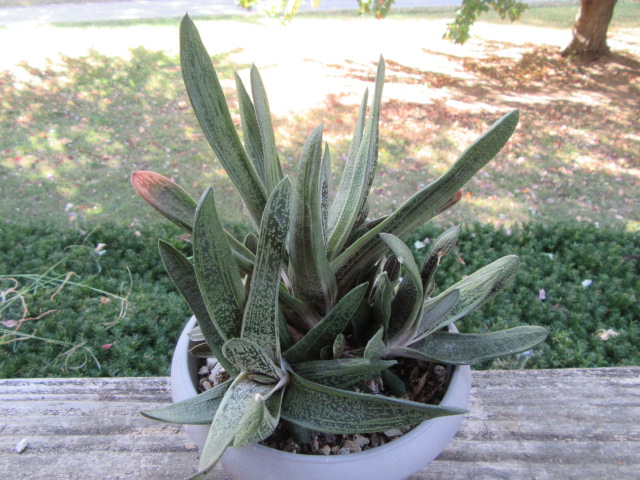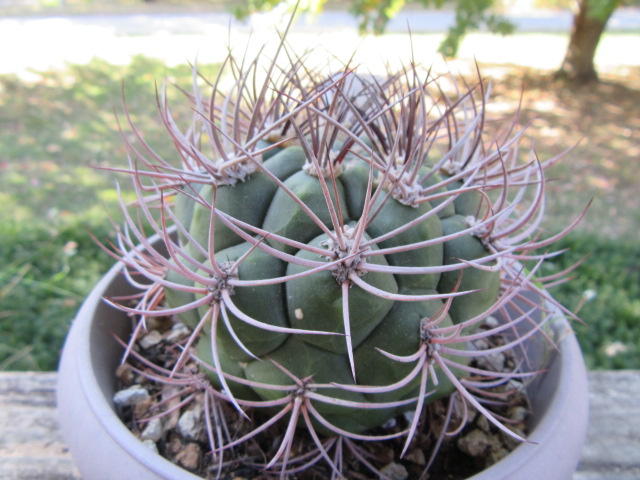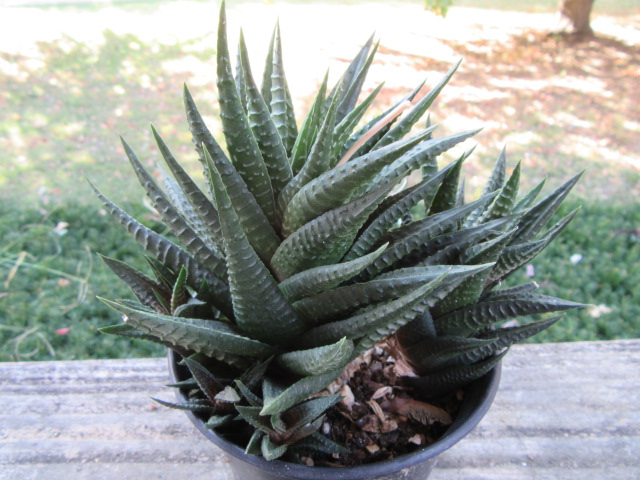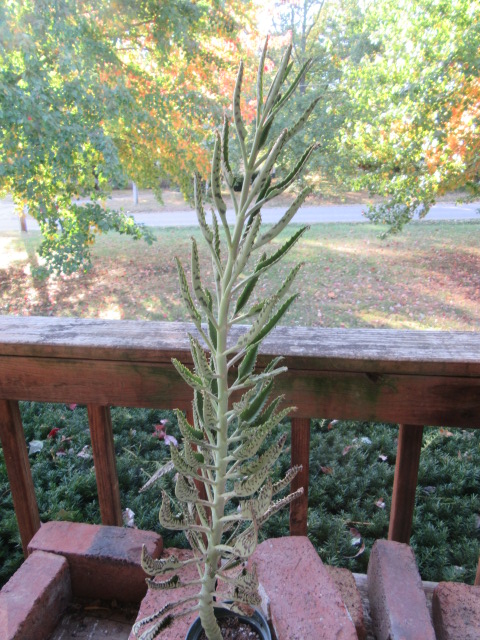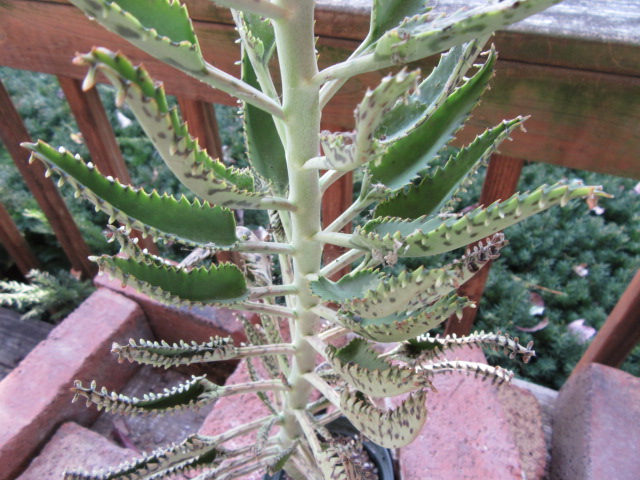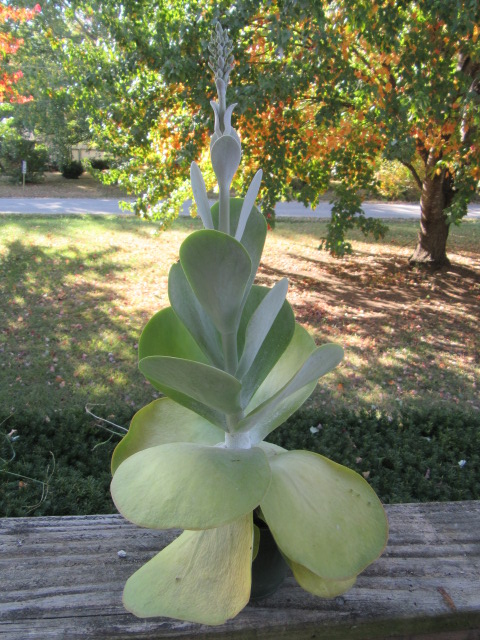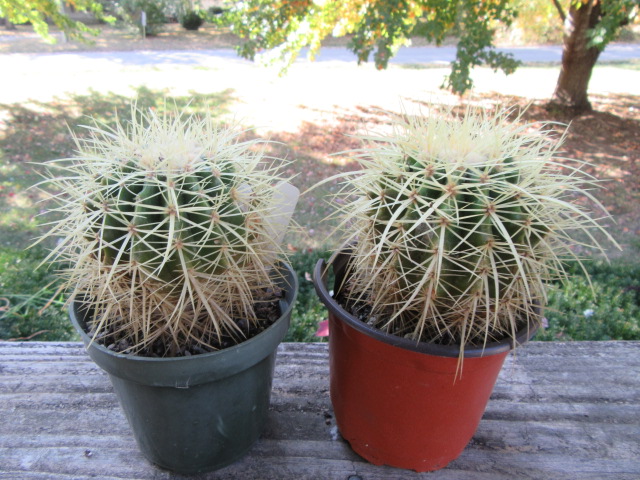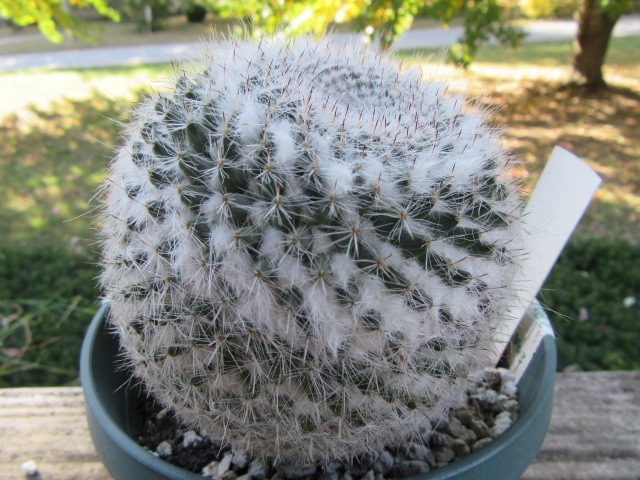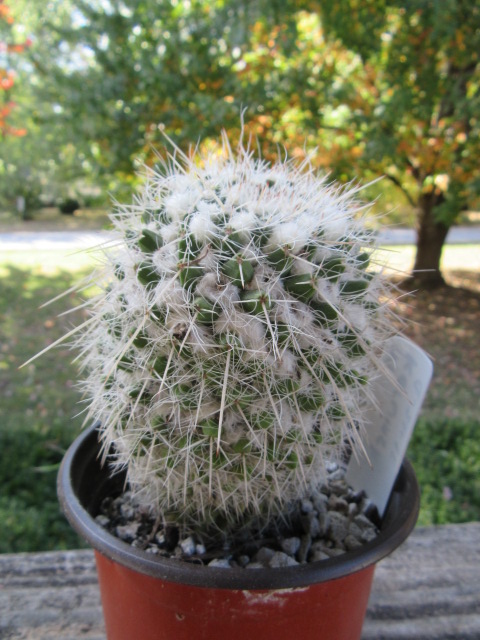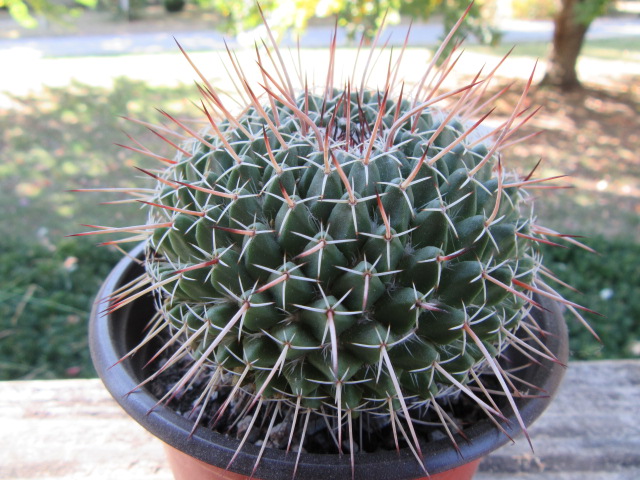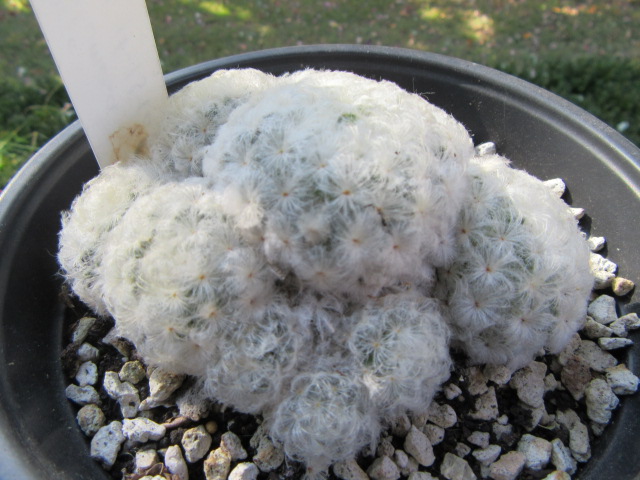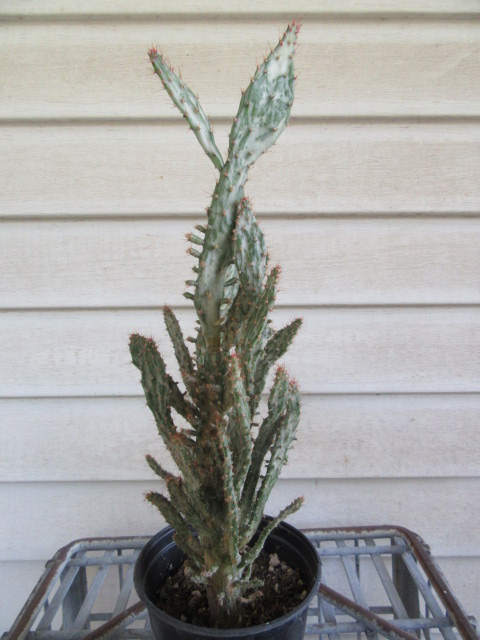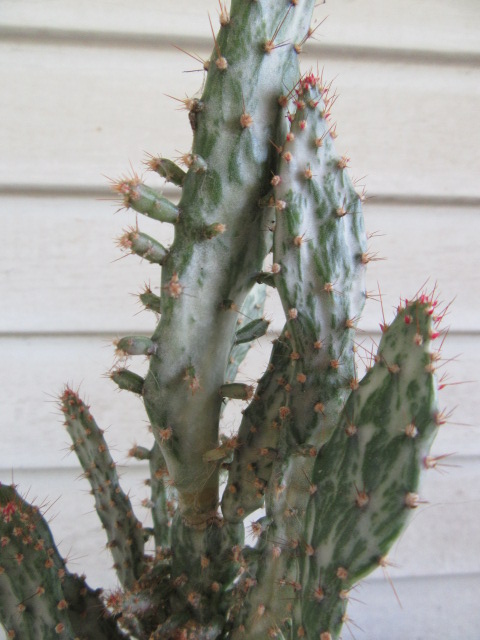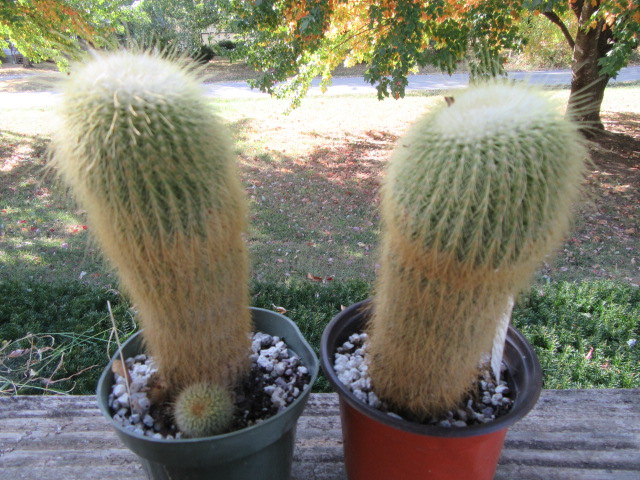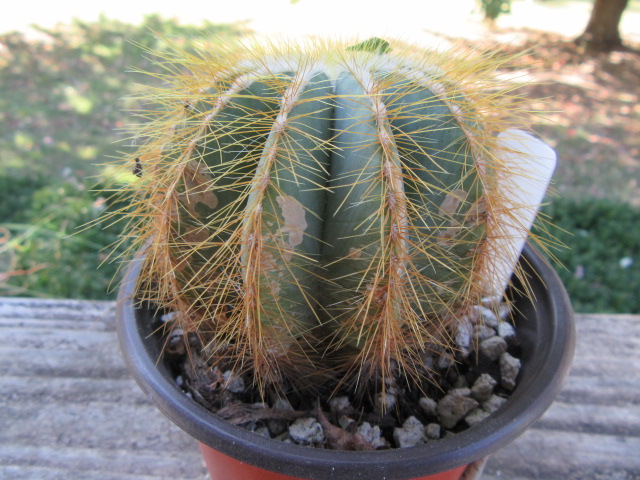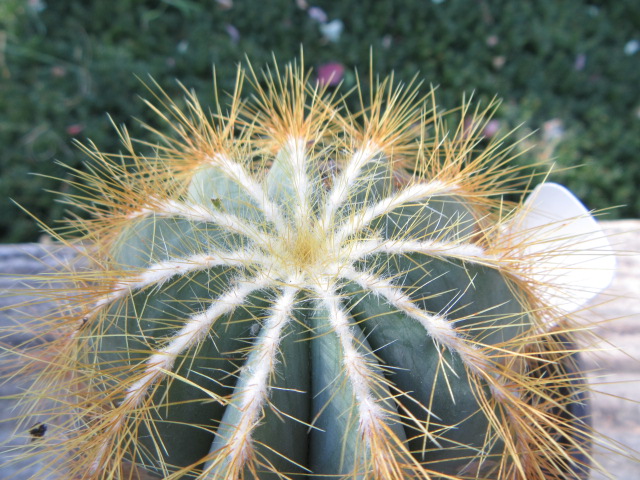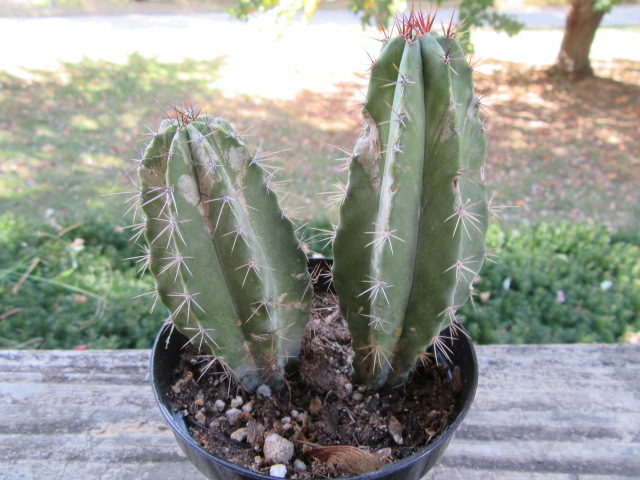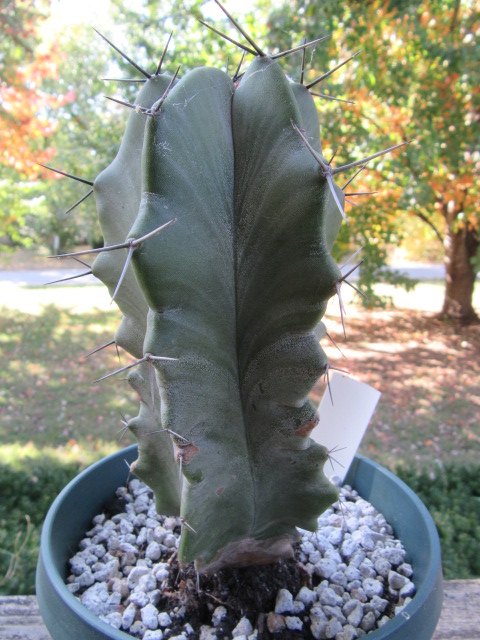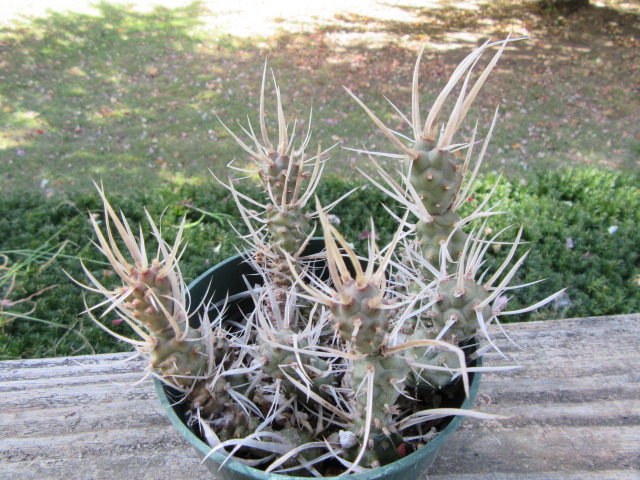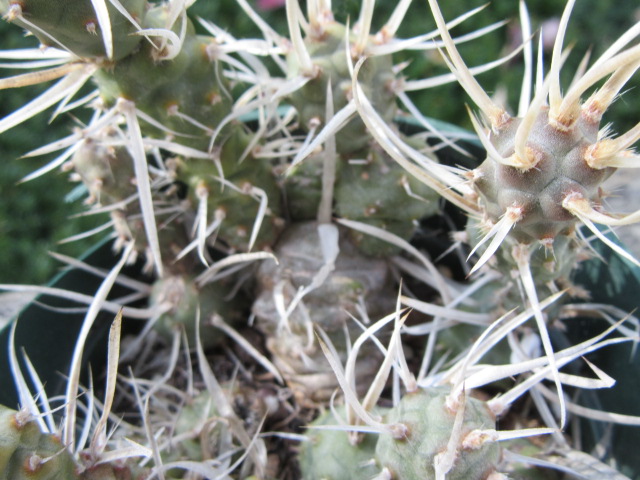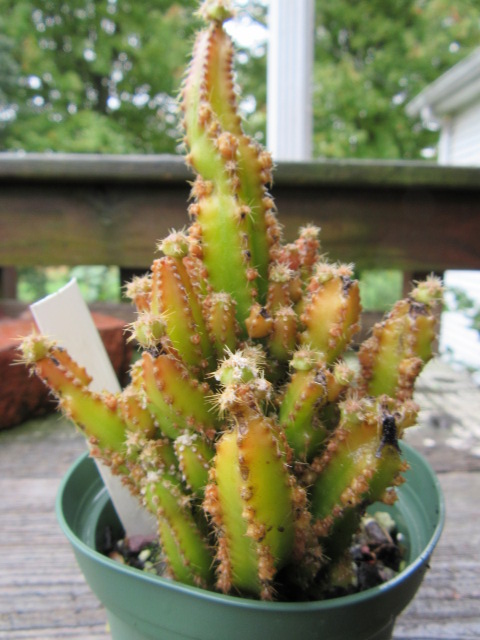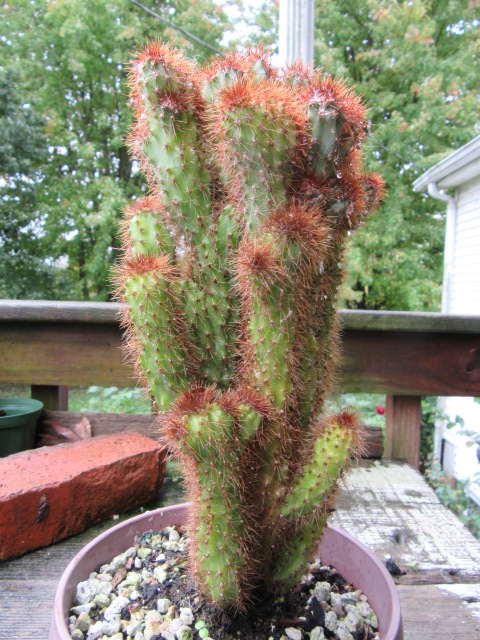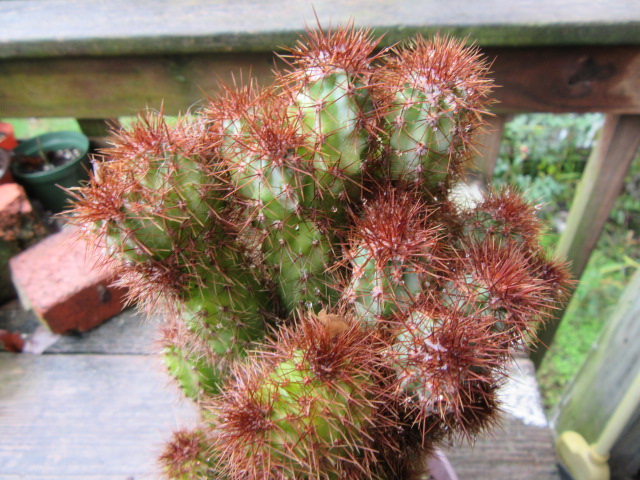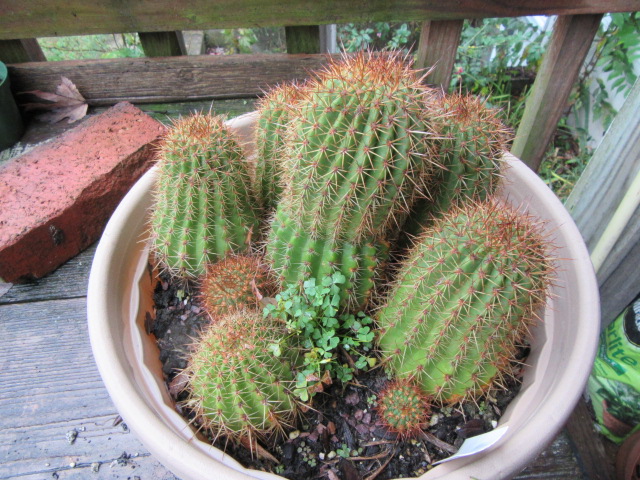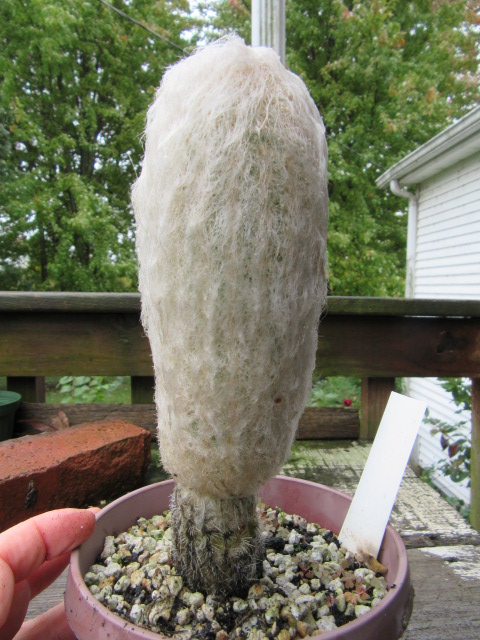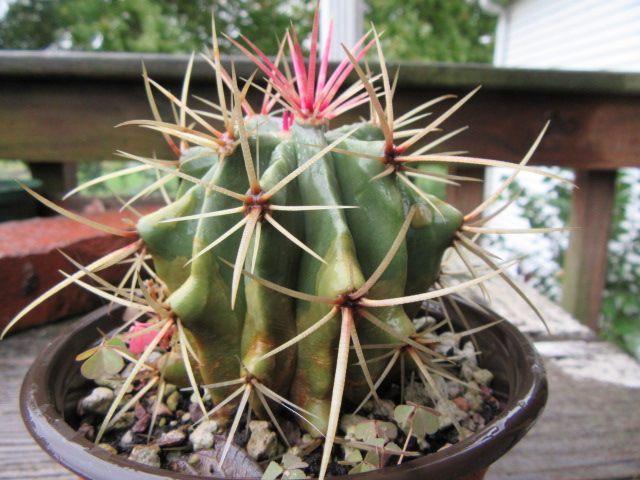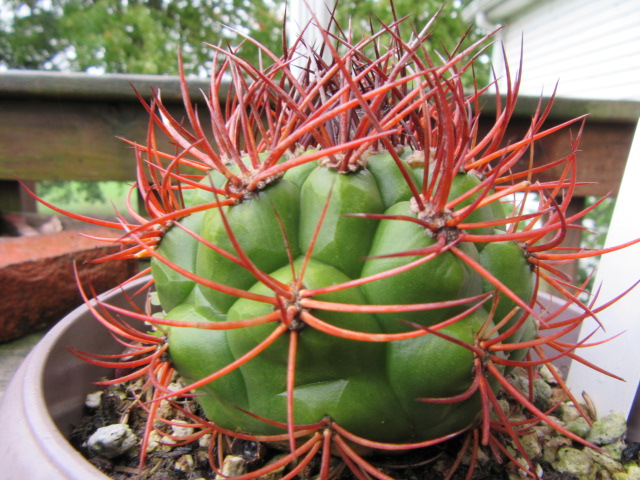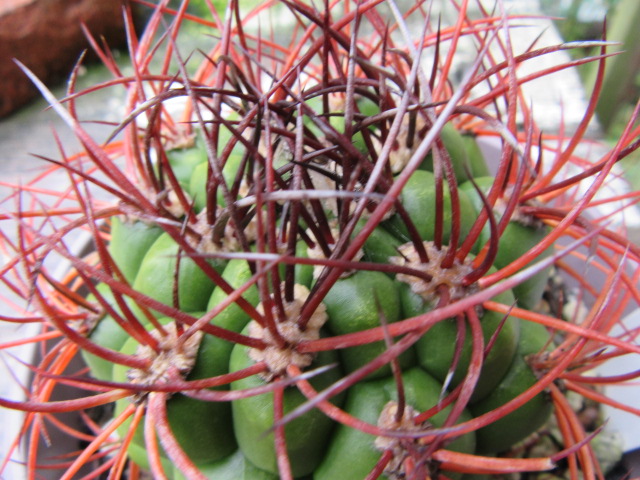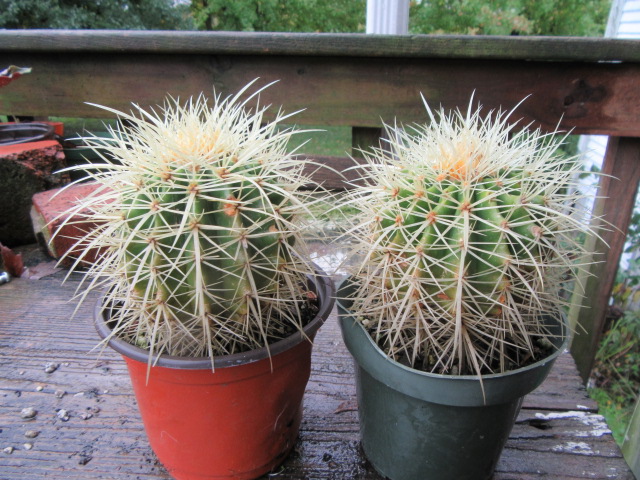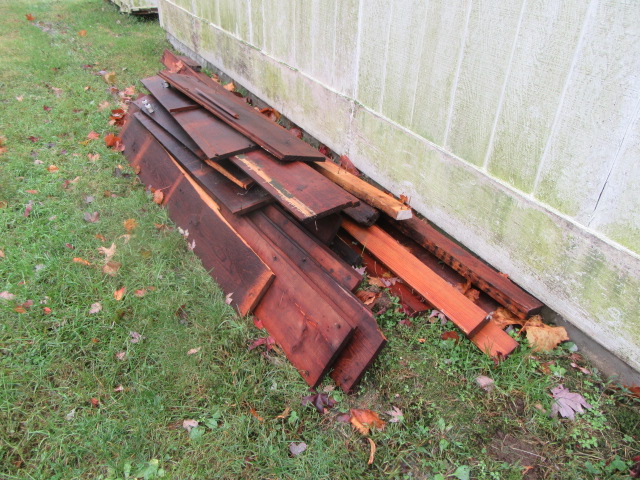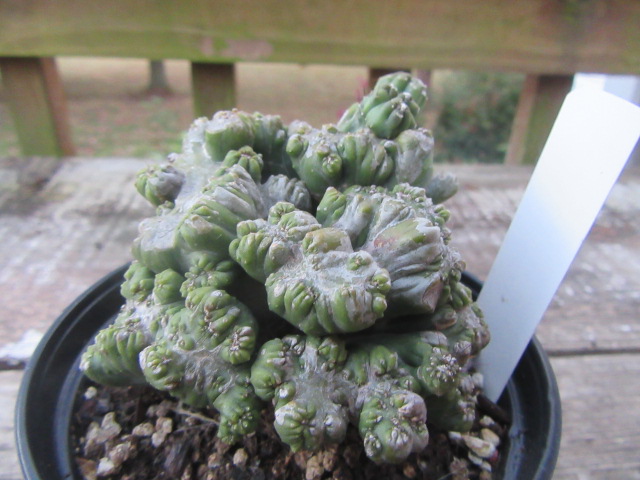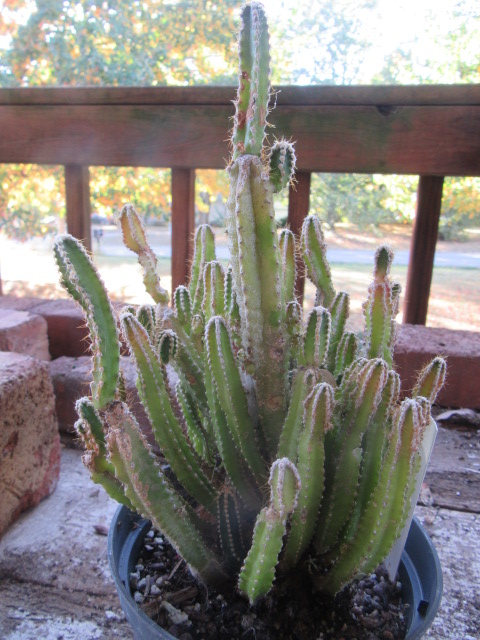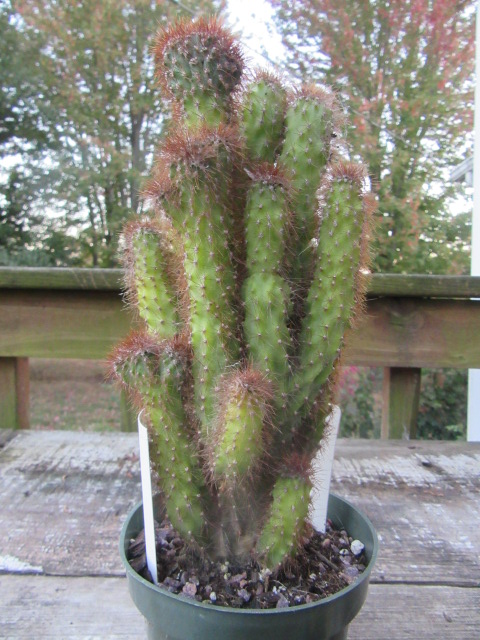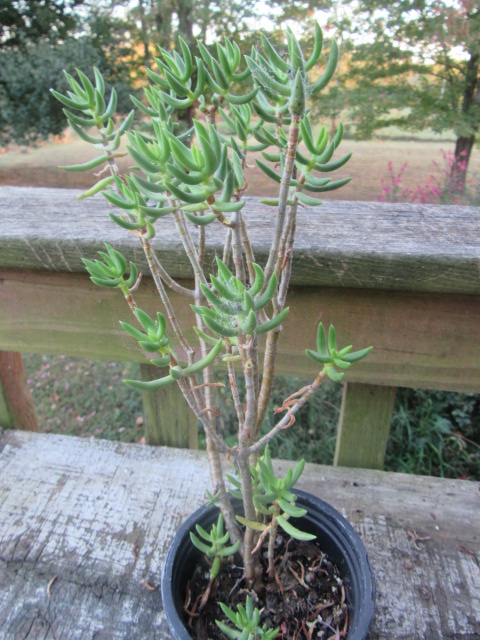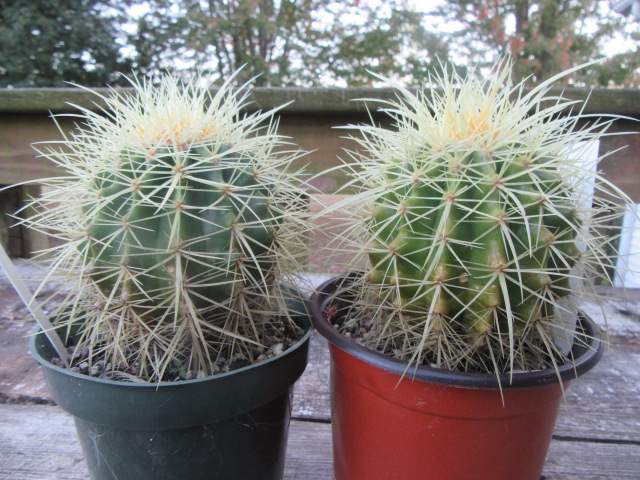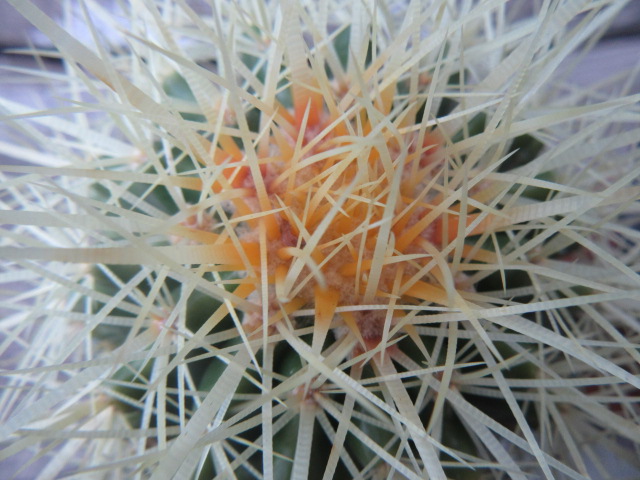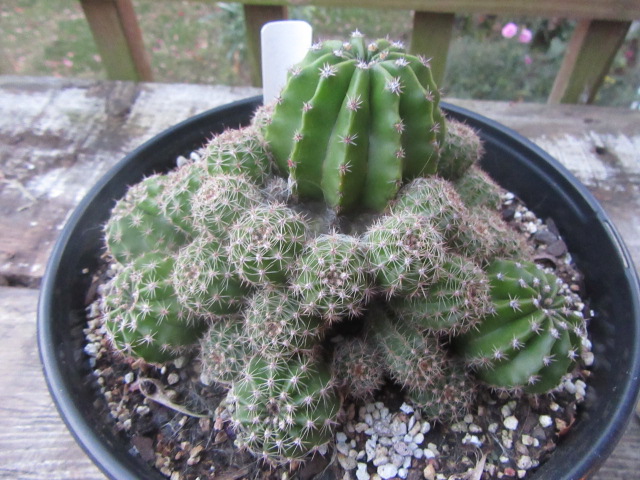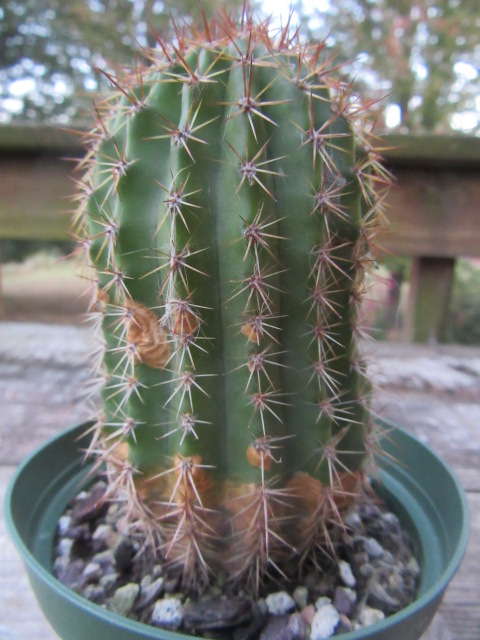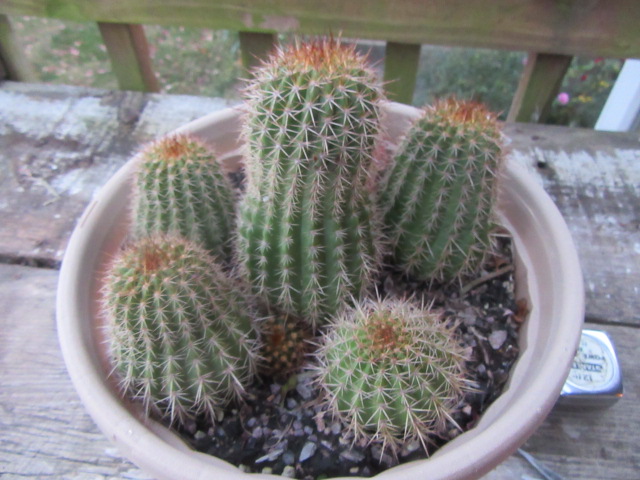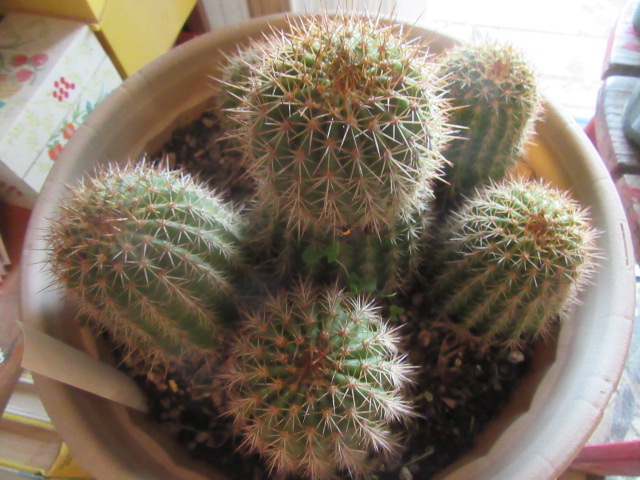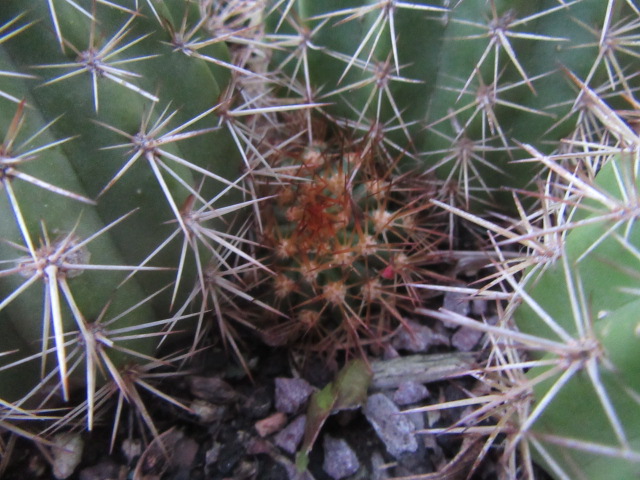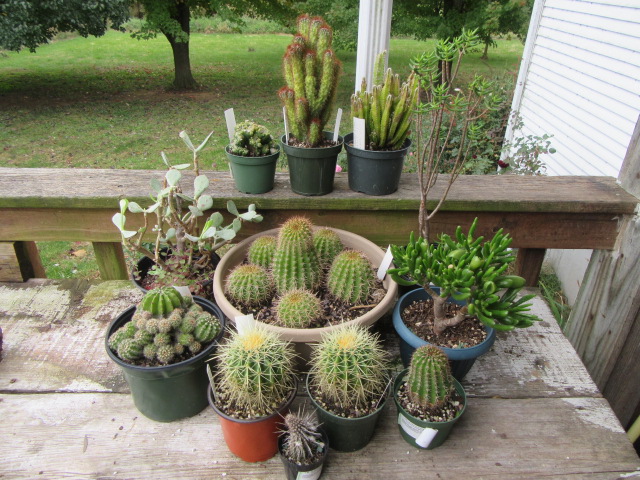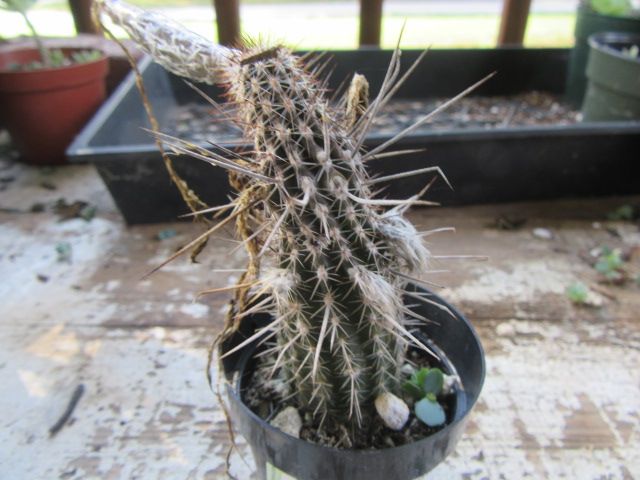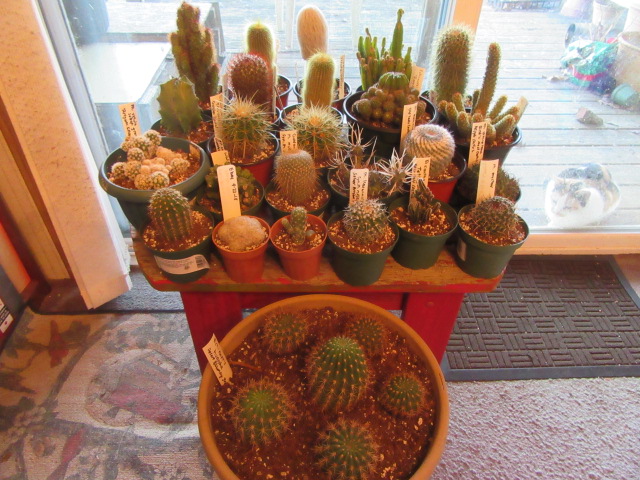
Family Photo on 12-15-18, #539-1.
Hello everyone! I hope this post finds you all well. I have been wanting to talk about cacti, so I started this post with the first set of photos on November 29. It was a nice spring-like day that I wish every day during the winter was like. I took all the cactus outside, a few at a time, to take their photos then put them back in the house. I have only 25 pots of cactus representing maybe, umm, 23 species. There were three times I accidentally bought two of the same species and didn’t realize it until I was home taking their photos and writing about them. Oh yeah, then there is the small fellow that is apparently a Mammillaria vetula subsp. gracilis… I guess that kind of makes 22 species. After selecting the best photos I wound up with 36. Then I took close-ups on December 1 and a few after that. I had also completely forgotten about the Cylindropuntia imbricata that was outside, so I had to take photos of it on December 3.
Cactus are among the easiest of all pants to grow, at least in my opinion, and they don’t take up a lot of space. You learn how to handle them so you won’t get stuck and it helps to have hard skin (and sometimes leather gloves). I always measure my cactus when I bring them inside for the winter because they grow kind of slow. I did that on October 10. I measure them because I want to compare the measurements from the year before and when I bought them. I know they are growing, too, because I have upgraded them to larger pots.
For some reason, cacti remind me of what one of my all-time favorite philosophers had to say.
Doing nothing often leads to the very best of everything.
Winnie The Pooh
If you think about, cactus at times seems to just be sitting there doing nothing. They don’t have leaves like other plants which can tell you a lot of things. Leaves can tell you when a plant is happy, when the plant needs water, when it is dying, etc. Well, some cactus species do have leaves and their spines are actually sort of modified leaves in a roundabout way. Evolution…
CACTUS ANATOMY
One of the major reasons I am writing this post is to show some of the differences between the species I am currently growing. I found a good illustration online from Science-art.com but the artist was no longer on the website. The site manager gave me the artist’s email address but I haven’t heard back from him. With some advice and inspiration from Jim Ruebush (How I See It), I made an attempt to create my own… I am not an artist but Jim suggested I try using the Preview on my iMac. I only use Preview to view photos and didn’t know what else it could be used for. After five years. 🙂
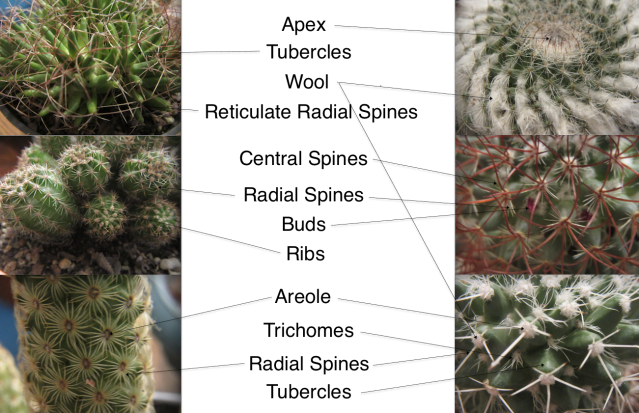
Well… Ummm… The photos are MUCH smaller once I posted them than they were on the screen so you can’t hardly see where the lines are going. I had an idea in my mind that I had to try and make work. I had to make the photos smaller and they had to be a certain distance apart or it wouldn’t work. I hope it is understandable. A cactus is a lot more than just a plant with a lot of sharp needles. They are very complex and through MANY years of evolving have developed their own special way of surviving in their environment.
With the diagram above, the definitions below, and descriptions of each plant on this post, I hope you will have a better understanding of how unique and easy to grow they really are. I must say I learned A LOT while writing this post. The definitions are basically for the plants I am growing (for the most part).
DEFINITIONS OF WORDS IN THIS POST:
These are just a few words from the CactiGuide glossary and maybe not all used in this post. Umm… I added a few comments along the way.
Acicular (subulate-acicular) Spines: Thick spines, more or less flattened, straight or slightly curved. Information uses Ferocactus pilosus as an example but I think my Echinocactus grusonii is another example.
Areole-Unique to cacti (as far as plants go), the areole grows from the end of the tubercles. The areoles on some species are sort of woolly or “felted” and is where the central and radial spines grow from. Glochids from some species also grow from the areoles as with Opuntia species (Prickly Pear).
Apex-the center top part of the stem. In many species the apex is concave. I guess the center of everything is the apex, huh?
Axil-The axil is a little more difficult to describe. An axil surrounds the apex but there is also an apex around the tubercles. It is kind of like a valley between two hills or mountains. The axil around the apex is where the spines appear to unfold as the plant grows. Kind of like a new beginning on both sides (with no end in sight). 🙂 I think the area between the tubercles and ribs (depending on the genera and species) is also an apex. Not 100% sure about that though.
Bristle-Stiffened hair. This is interesting… The description of one of the cactus is stiffened hair around the apex. When I think of stiffened hair I think of a pig’s hair. I look and I only see spines… I guess if I actually saw stiffened hairs now I would know they are bristles. 🙂
Cactophile-Hmmm. Says a person who likes cacti.
Centripetal-Tending inwards to the center or axis… I guess this is like where the spines around the axil (by the apex (top of the plant)) are pointing inward.
Central Spines-The spines coming from the center of the areole.
Diumal-flowers that only open during the day.
Glochids- are the dreaded tiny spines that come off very easily and get stuck in your skin. They are very irritating because they are very hard to remove. You can’t see them, but you can feel them. Information says glochids are modified leaves that conserve moisture. (Barbed spines or hairs, mostly small and brittle; often in tufts, characteristic of the Opuntioideae.)
Imbricate-Overlapping. As with the Cylindropuntia imbricata (Tree Cholla).
Orthostichy-Arrangement of nodes, areoles and so on in a vertical row (see Spirostichy). As with vertical growing, columnar cactus with ribs whose areoles grow one above the other.
Parastichy-Secondary spiral in phyllotaxis. I think this is where some Mammillaria species appear to have spirals going in two directions.
Phyllotaxis-Mode of arrangement of leaves in relation to the axis. The dictionary says the arrangement of leaves on an axis or stem.
Pruinose-Frosted appearance with a white powdery coating. The Stenocereus pruinosus may be a good example.
Radial Spines-The spines arranged around the edge of the areole. Some species have no radial spines while others have an unbelievable amount. Some species have hair-like radial spines while others are thick and very sharp. Spines can also be curved inward.
Recurved-Spines that are curved backward.
Reflexed-Spines that are curved downward. Some species have central spines that are curved in both directions.
Reticulate-Spines that are very long that criss-cross forming a net-like appearance around the plant. As with the Mammillaria decipiens.
Rib-Whereas Mammillaria species have tubercles, most other cacti have ribs that the areoles grow on. Some are fairly straight while others are wavy. Ummm… Wavy edges are called “sinuate”.
Spines-The CactiGuide glossary says, “Sharp-pointed, hard or woody structures, derived, in cacti, from leaves.” Hmmm…
Spirostichy-The arrangement of nodes, areoles and so forth in spiral rows (see Orthostichy).
Stem-The body of the cactus.
Tubercles-Umm… The dictionary says, “In anatomy, a tubercle is any round, small eminence, or warty outgrowth found on external or internal organs or a plant or animal.” The photo shown is of a Mammillaria. In this case, tubercles are produced by the Mammillaria species and are sometimes referred to as nipples. I would hardly call nipples a warty outgrowth.
Wool-A dense covering of fine soft hairs. GEEZ!
POTTING AND RE-POTTING
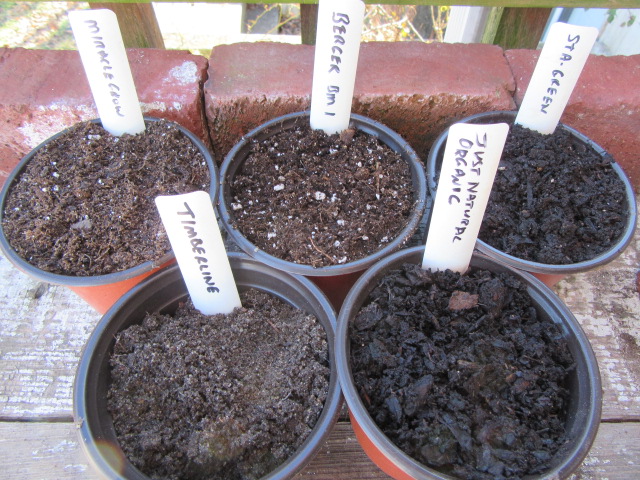
Different potting soils on 12-15-18, #539-2. Back row from left to right: Miracle Grow, Berger BM 1, Sta-Green. Front row: Timberline and Just Natural Organic Garden Soil.
Potting soil is definitely not created equal. Most commercially available potting soil contains a lot of peat (in one form or another). One of the most frequently asked questions from beginners is about the potting soil for their cactus. If you get online you can find a lot of recipes and some get a little elaborate. For many years I stuck with 2 parts of potting soil with 1 part chicken grit and 1 part perlite. I always wanted the water to drain out almost as fast as it was put in.
The above photo shows five different mixes I have used. Miracle Grow Potting soil works very well for potted plants and has a lot of coarse material. I have used it a lot amended with additional perlite and chicken grit (2-1-1). I also like Schultz Potting Soil for cactus and succulents because it has much less big chunks of bark. Both Miracle Grow and Schultz have timed-release fertilizer. I bought a BIG bag of Berger BM 1 from one of the local greenhouses which is a premium blend used by a lot of greenhouses. There are absolutely no chunks of anything and it has A LOT of perlite and NO fertilizer. For the most part, greenhouses foliar feed their plants so they don’t need a mix with fertilizer. Sta-Green is very interesting. Kind of chunky, very little perlite, visible fertilizer, and VERY BLACK. I bought the bag of Timberline several years ago and when I amended it with grit and perlite it became hard as a brick after watering. I think it is mainly due to the high sand content. There is no list of ingredients on the bag. I bought the All-Natural Organic Garden soil this spring because the bag had a hole in it so I got it very cheap. It is GREAT but not for cactus… I use it when I mix soil for the Alocasia and some of the other potted plants and it has some very good ingredients. I experimented with these different types to see how fast they dry out and re-absorb water. Even though the Berger dries out quickly, it also re-absorbs better than Miracle Grow. The Sta-Green took longer to dry out and seemed to re-absorb OK. The hardest to re-absorb once it was completely dry was the Miracle Grow. So, which one was best for cactus? I would have to probably say none of them… As far as cactus is concerned, there is something wrong with all of them. I didn’t buy any Schultz Potting Soil this past year but perhaps I will use it again in 2019. I am seriously tempted to try dirt… Get it from the molehills, add the pumice, maybe some grit… Maybe that wouldn’t be a good idea but you never know until you try… If you get right down to the nitty-gritty, in the wild, not all cactus grow in the same type of soil. Also, contrary to what many might think, even though many cactus grow in the desert it doesn’t mean their soil is not fertile. As long as their potting mix absorbs fast, drains well, drys out soon, and remains loose, I don’t think they really care what they are growing in. Maybe we are the ones with the issue…
Cactus and succulents need a very fast draining mix. All potting soil, when it is fresh from the bag, absorbs water and drains well. You water your plants on a regular basis over the summer and all is well. BUT, when you allow the soil to dry out it becomes very difficult to get it to absorb again. This is because peat (in one form or another) is the main ingredient. Peat is the main ingredient in potting soil because of its water retention ability. Water retention is NOT what cactus and succulents need. What they do need is a mix or recipe that absorbs and drains quickly, will dry out soon, and re-absorbs quickly and so on time after time. That is where it gets complicated.
I have no problems over the summer because I am continually watering all the plants. For the most part, I water the cactus and succulents at the same time but I just don’t give them as much. I just go over their pots fairly quickly instead of holding the wand over it until it is fully saturated and flooding out the bottom. Well, the cactus pots are smaller for the most part and so it doesn’t take as long either.
The problem arises over the winter when I am not watering the cactus or succulents as often. Let’s just make it simpler and talk about cactus without getting into succulents. While cactus appreciate normal watering during the summer months, they don’t really need much, if any, during the winter. As a result, their mix always becomes hard. You may notice once the potting soil dries out it has pulled away from the sides of the pot. So, when you do water it runs down the side of the pot instead of re-absorbing into the mix.
They need their soil to be loose, light, and airy.
One of the other questions is when to re-pot which I will talk about in a minute…
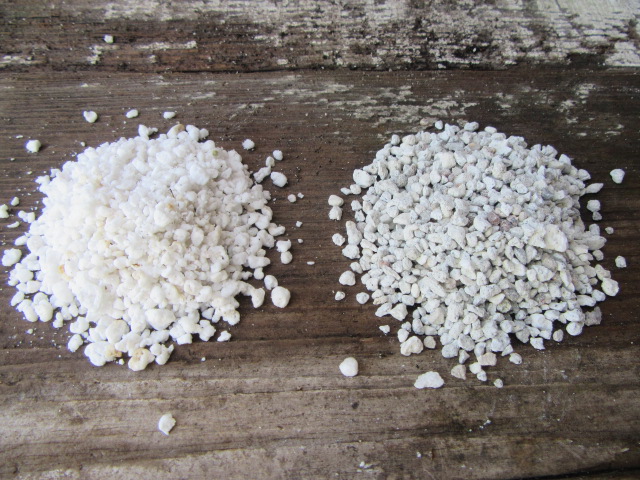
PERLITE (left) VS. PUMICE (right)
When I started following a few cacti and succulent groups on Facebook, they recommended using pumice instead of perlite. They also don’t recommend using a “peat-based” potting soil. OK, now that is hard to do. The other thing is that pumice was nowhere to be found locally. Many of the cactus and succulent enthusiasts also use a product called Dry Stall which is pumice for a fraction of the cost. (There is another product called Stall Dry which is diatomaceous earth). Well, I checked for Dry Stall locally and it was nowhere to found either. I called the company and they said there were no distributors past a certain point (but I forgot what she said). I found it online and it only cost around $14.00 for a 40# bag but the shipping was $64.00. So, I wound up buying a 15# bag from General Pumice from California. It was $27.00 with free shipping. You can get it on Ebay from people who sell it in smaller quantities. If you only have a few cactus and succulents you may not want to buy a big bag. BUT, you also have to consider growing cactus and succulents is very addictive when they do well…
Now, what is pumice and what is perlite? Perlite is an ingredient in all potting soil mix along with vermiculite and a lot of other stuff. Perlite is a volcanic glass that is heated to 1,600° F so it puffs up to 13 times its normal size. Water is retained in its tiny pores which it releases later. Of course, since it is very lightweight, it can float to the top of a soil mix. It kind of reminds me of styrofoam balls… It can also be crushed if you squeeze it. The Gardening Know How website says perlite can cause fluoride burn on houseplants…
Pumice is a porous volcanic rock and, like perlite, has tiny microscopic pores on its surface that absorb water. Pumice, however, is not heated or puffed up. It also contains vitamins and trace minerals that go into the soil as the moisture is released. In texture, it seems similar to grit, it does not decompose, and never needs to be replaced. It will not float to the surface like perlite but stays where it is supposed to, with the plant’s roots.
I had been itching to try out the pumice so I repotted a few cactus when I moved them on October 10. That’s when it struck me… All this time I had been having problems with the soil in the cactus and succulent pots getting very hard over the winter (as I mentioned earlier). I realized repotting the cactus when I bring them inside would mean their soil would be loose all winter. 🙂
Since potting soil already contains perlite and the pumice seemed similar in consistency to the grit, I wondered why I had to even use the grit. I asked the “guy” at General Pumice what size he recommended (since they have three sizes) and what he suggested as the ratio to use with potting soil. He recommended using it 50/50. So, for the most part, that’s what I did… Now the soil is nice and loose for the cactus and I also re-potted a few of the succulents.
I have been asked when is a good time to re-pot cactus and what size of pot. Typically, I would have said spring for several reasons. If you use a potting mix, such as Miracle Grow with a timed-release fertilizer, they don’t need fertilizer during the winter months. However, since you won’t be watering them over the winter, that really doesn’t make that much difference since it is the watering that releases the fertilizer. But, since I repotted most of the cactus on October 10, I guess I have switched gears a little. I guess the best time to re-pot is when they need it. If their pot is getting crowded then they need re-potting. As far as pot size goes you have to look at several things. One thing you have to consider is that cactus doesn’t typically have much of a root system. Many times I have been fooled, though. Typically, their mass of roots is right under the plant so they don’t need a much wider pot than the width of the plant and only a couple of inches deeper than their roots. To much extra soil means water that is not being absorbed by the roots which can lead to rotting… Typically, when I re-pot, I only increase the size of the pot by an inch or so, more or less. It just depends on the plant and how fast it grows and what its roots look like when you remove it from the pot. If you are using potting soil with timed-release fertilizer, the fertilizer is only good for a period of time. So, re-potting in the spring will give you fertilizer for the growing period and you don’t need it after that. GEEZ! I am confusing myself… Now, plants that grow taller rather than wider need a wider pot because they can become top-heavy and fall over. Finding the right pot on hand can be difficult sometimes. Pots for bonsai would seem to be a good choice because they are shallow and usually wider. Not sure, though, because I have never tried a bonsai pot…
I almost forgot to talk about light… For a long time, I have been pretty much growing my cactus in light shade under the Chinese Elm in “the other yard”. When plants are grown inside over the winter, they have to be introduced to more light gradually. The elm tree was great because it provided a shady spot early. Then as the beetles at the leaves, they automatically get more sun. I had to move them this summer because the Japanese Beetles were so bad and they started sampling the plants. So, I put the cactus on the back porch in full sun and they did very well. Most cactus do well in full sun to light shade and some even in part shade. Succulents that aren’t cactus (since cactus are succulents) are a little more tricky and the different genus and species require different light levels. Some need full sun to perform best while it will burn others.
Now for my spiny companions… From A-Z. Please forgive my continual rambling about scientific names. 🙂
—-<<<<+>>>>—-
Acanthocereus tetragonus
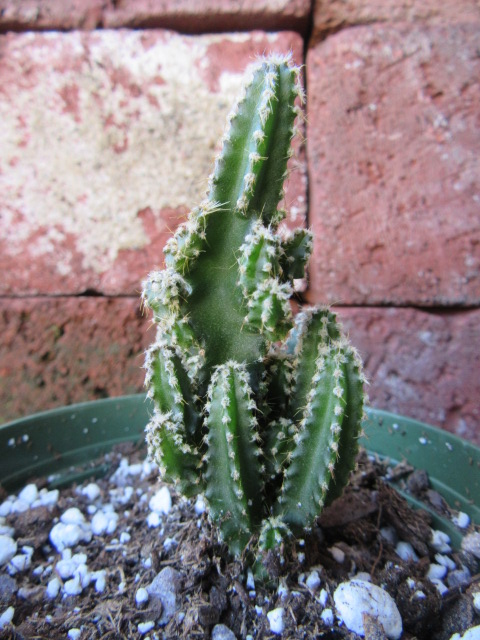
Acanthocereus tetragonus… Fairytale Castle.
I picked up this little Acanthocereus tetragonus from Wagler’s Greenhouse in September when I took a few plants to them. Of course, it was unlabeled… You can view this plant’s own page by clicking HERE. There is A LOT of confusion between this plant and the Cereus hildmannianus subsp. uruguayanus. In the wild, both species are tall growing, ribbed and columnar plants. Both also seem to have “miniature” versions with the same or similar common or cultivar names. Both are listed as “Fairytale Castle”, “Fairy Castle”, “Fairy….” You get the point. The miniature “forms” were found in cultivation, not in the wild. “In cultivation” means in someone’s collection, a flower bed, or a greenhouse, etc. Maybe their growth was stunted because they were in a small pot. Who knows.
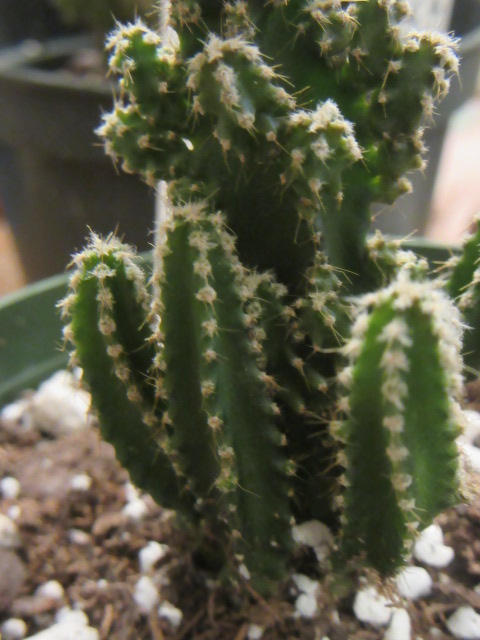
Getting a good close-up of this cactus wasn’t easy because it is so small. Its stems are five-sided with areoles having tiny tufts of wool with very short spines. Information suggests this plant needs plenty of space and deep soil. It is supposed to branch out profusely and form large clumps… At only 2 7/8″ tall we have a ways to go. It is currently 2 7/8″ tall. I didn’t re-pot this cactus when I moved them inside because it was re-potted after I brought it home. You can see the perlite on top of the soil… I gave this plant a little more room than I normally would a smaller cactus. 1 3/4″ between the base and the side of the pot.
One confusing thing when doing research about this plant is that several websites have the two plants confused (even though they are probably confident). Some list it as one name with photographs of the other. I have both now, so I can definitely see a difference. One website lists this plant as Acanthocereus tetragonus ‘Fairy Castles” and said after ten years it was only 16″ tall. The photo is of a very nice what appears to me to be a Cereus hildmannianus subsp. uruguayanus. Even one of the pages on Dave’s Garden… OK. I will stop…
—-<<<<+>>>>—-
The Cereus Group…
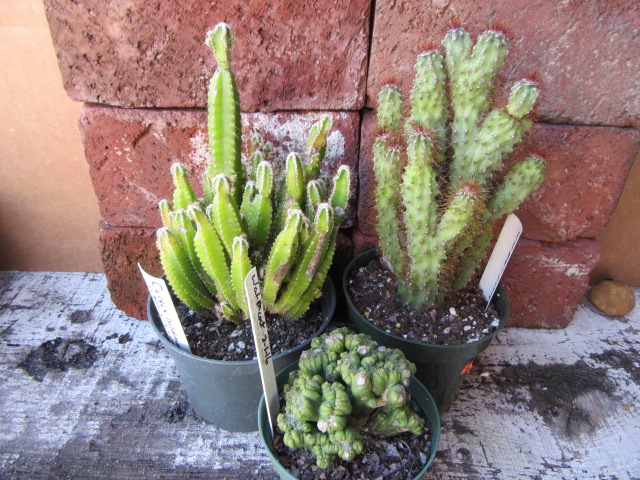
The genus, Cereus Mill., was named and described by Philip Miller in the fourth edition of Gardener’s Dictionary in 1754.
Cereus in the wild are typically very large, ribbed, and columnar growing cactus, but there are also species that are epiphytic. Plants of the World Online by Kew currently list only 25 accented species of Cereus. They are still uploading data so this could change. Version 1.1 (2013) of The Plant List named 48 accepted species (plus 4 of infraspecific rank), a total of 254 synonyms, and 456 still unresolved. Llifle (Encyclopedia of Living Forms) list 136 Cereus species (both accepted and synonyms mixed up) and a WHOPPING 691 former species that have been moved to other genera!
The tree-like Cereus species look so much alike and even similar to species of other genera. Actually… There used to be MANY more species in the Cereus genus because their true identity was unknown at the time. The species that still remain in the genus all have certain characteristics only known to Cereus. Other species have been moved to several other genera. One author wrote, “Inclusion by lack of exclusion has made for a very messy and unsatisfactory group.”
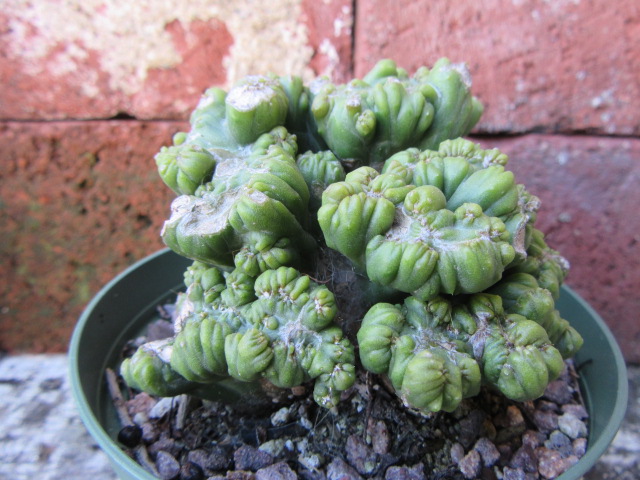
Cereus forbesii f. monstrose ‘Ming Thing’ on 11-29-18, #534-3.
I bought my first Cereus forbesii f. monstrose ‘Ming Thing’ in 2009 while living at the mansion in Mississippi. It was fairly large and the pot was bulging. While re-potting in 2010 I noticed it could be divided. So, I did that and wound up with three pots. Dividing cactus like that is not necessary and is probably best to allow them to grow as they choose (which is my own opinion and I was a newbie at the time). I bought my current ‘Ming Thing’ on July 19, 2016. It currently measures 2 1/8″ tall 3 1/4″ wide. It grows EVER SO SSSSLLLLOOOOWWWWLLLLYYYY…
There are several species of Cereus that develop strange looking “monstruosus”, “monstrous”, or “crested” forms in the wild. Some cultivars, such as ‘Ming Thing’, have also undergone further, ummm, manipulation in cultivation. The species, Cereus forbesii, is a fairly large, columnar, tree-like cactus that grows in a wide variety of habitats in several countries in South America.
Cereus forbesii C.F. Först. was named and described by Carl Friedrich Förster in Handbuch der Cacteenkunde in 1846. It was FIRST documented by Christoph Friedrich Otto (with other authors) in Cactaceae in Horto Dyckensi Cultae in 1844. I wrote a much longer summary of the accepted scientific name of the species but decided to delete it. I outlined the confusion on the plant’s own page and you can read about it HERE if you choose. I was beginning to get confused AGAIN.
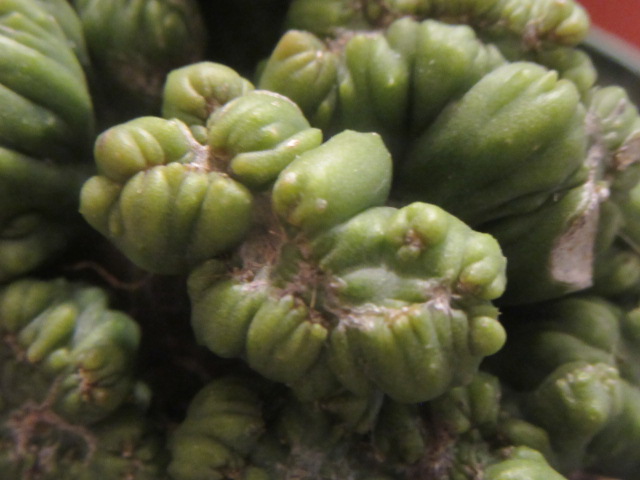
A closer look at Cereus forbesii f. monstrose ‘Ming Thing’ on 12-1-18, #535-2.
The common name on the tag says “Curiosity Plant”. That name says a lot because it is definitely curious looking. Kind of reminds me of closed hands with the fingers curled inward (facing upward). I have found Cereus forbesii f. monstrose ‘Ming Thing’ to be undemanding and very easy to care for. The scars on this plant are from hungry crickets…
Ummm. “Curiosity Plant” is not necessarily a legit common name. ‘Ming Thing’ may not be a “registered” cultivar name. Come to think of it, Cereus forbesii f. monstrose isn’t even an accepted name either… Maybe someday. 🙂
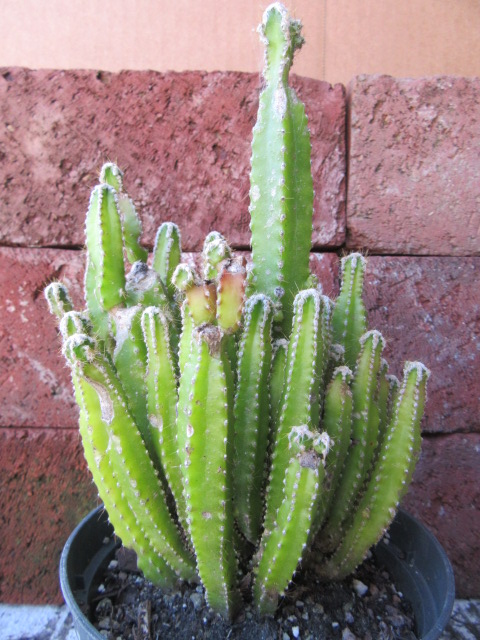
Cereus hildmannianus subsp. uruguayanus on 11-29-18, #534-4.
I bought this Cereus hildmannianus subsp. uruguayanus (Fairy Castles, Peruvian Apple, Queen of the Night, ETC.) from Wal-Mart on January 28, 2016. We have had our ups and downs and at one point I thought it was going to die. It has also had its battles with crickets. For some reason, it isn’t the bright green it was when I first brought it home although it seems to be OK now. You can view this plant’s own page by clicking HERE. At 7 1/4″ tall x 4 1/2″ wide, it has grown 1 1/8″ taller x 1 1/2″ wider than when I brought it home.
I have to do some tweaking on the plant’s page because I am somewhat confused… I wasn’t confused until I did research on the Acanthocereus tetragonus… They are both cited as being Fairy Castles. For a while, I was content in calling the Acanthocereus tetragonus Fairytale Castle and this one Fairy Castles. Oh, I better stop right here or I will be repeating myself AGAIN…
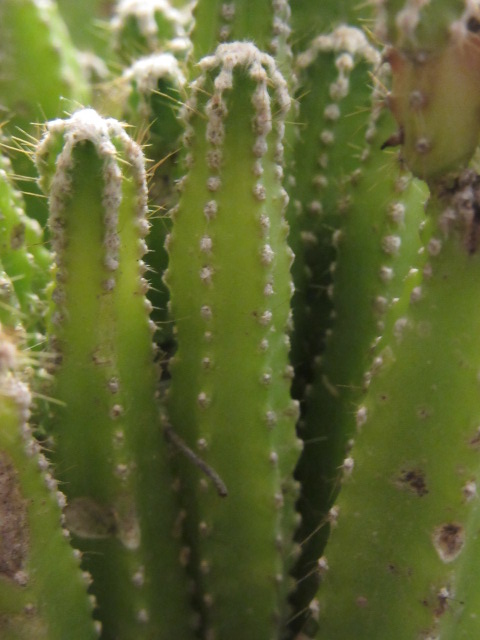
A close-up of Cereus hildmannianus subsp. uruguayanus on 12-1-18, #535-3.
I took A LOT of photos of this one to get a good close-up. I do have somewhat of an issue with this plant being a Cereus hildmannianus subsp. uruguayanus although several experts have agreed that is what it is. It is supposed to have longer spines while the “species” is almost always spineless. My plant’s stems are somewhat spineless and what spines it does have are very thin and hair-like. Its areoles also have small wooly tufts mainly on newer growth and almost absent farther down the stem. The species is found in several countries in South America while the subspecies is only found in Uruguay. Of course, as I mentioned, they are MUCH taller in the wild than this miniature version… Some websites write Fairy Castles as a cultivar name and others as a common name. I am more likely to agree with it being a cultivar name since it is not a common name of the species or subspecies in the wild which grow MUCH taller. So, why didn’t I write it as a cultivar name? I have no clue…
Comparing the photos of the Acanthocereus tetragonus and Cereus hildmannianus subsp. uruguayanus, can’t you see the difference?
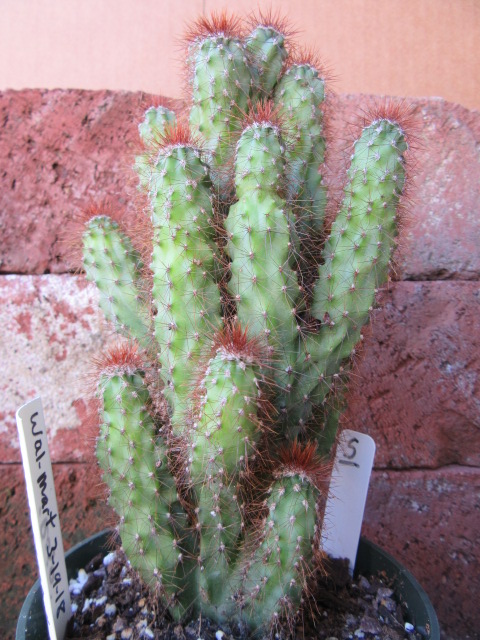
Cereus repandus f. monstruosus ‘Rojo’ on 11-29-18, #534-5.
This is the Cereus repandus f. monstruosus ‘Rojo’ I bought from Wal-Mart in March. It looks MUCH different than the one I bought while in 2009 in Mississippi. Both their labels said Cereus peruvianus monstrose ‘Rojo’. Cereus peruvianus has been a synonym of Cereus repandus for quite a while… Oh, wait a minute. I told you wrong… Cereus peruvianus (L.) Mill. is the synonym of Cereus repandus (L.) Mill. (how many periods after an abbreviation with a period?). Cereus peruvianus R.Kiesling became a synonym of Cereus hildmannianus K.Schum. (along with 26 other synonyms with Cereus validus Haw. being one of them, which is weird because it was also a synonym of… Someone please slap me!). Cereus peruvianus C.F.Först. became a synonym of Stenoereus eburneus (Salm-Dyck), which was previously Cereus eburneus Salm-Dyck, became a synonym of Stenocereus griseus (Haw.) Buxb……. Ummm… I was about to start writing about Cereus validus but that is another confusing story which would get Dave’s Garden into the mix…
OK, Dave’s Garden says Cereus forbesii ‘Ming Thing’ (above) is Cereus validus f. monstrose ‘Ming Thing’. How can that be? Plants of the World Online says Cereus validus is a synonym of Cereus hildmannianus. GEEZ! I forgot about the author’s names. Maybe several botanists named different plants the same name again. That’s how some species seem to have the same synonyms but their author’s abbreviations are different.
But, I am getting off-topic AGAIN… No wonder it takes so long for me to write a post and they are so long… You can view this plant’s own page by clicking HERE.
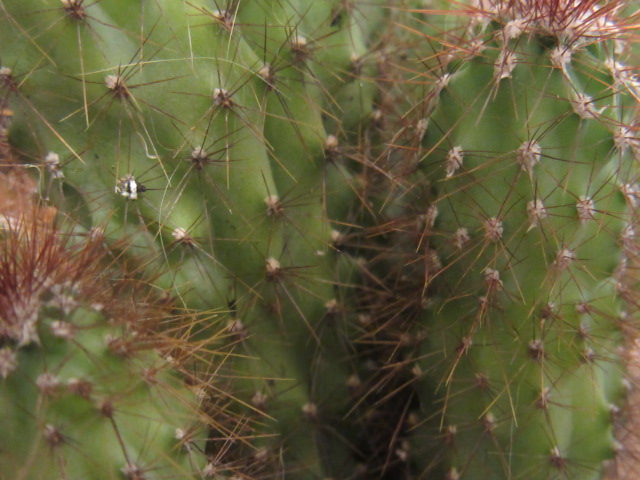
Cereus repandus f. monstruosus ‘Rojo’ up close on 12-1-18, #535-4.
Umm… Like I said, this one is much different than the one I had before. This one is more of an upright grower that is branching out. You can see the stems are kind of strange with no apparent pattern to the arrangement of their tubercles. Its areoles have small brownish radial and central spines and newer areoles have small tufts of wool.
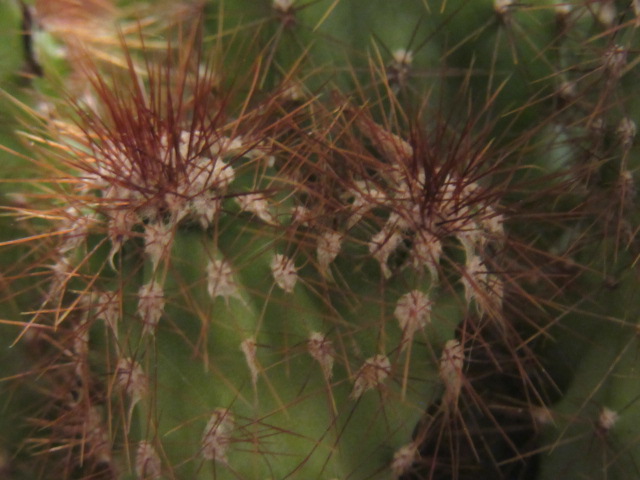
A closer look at the Cereus repandus f. monstruosus ‘Rojo’ on 12-1-18, #535-5.
Its spines are thin and wiry. You can run your finger down them and not get stuck.
I really like this cactus and I think I could easily fall for buying more. I think when you get into the monstruosus forms it becomes addictive. I am not a fan of the crested forms, though. When I moved the plants inside for the winter on October 10, it measured 6 7/8″ tall x 3 3/4″ wide. It was 5 1/2″ tall x 3 3/8″ when I bought it on March 19!
—-<<<<+>>>>—-
Cylindropuntia imbricata
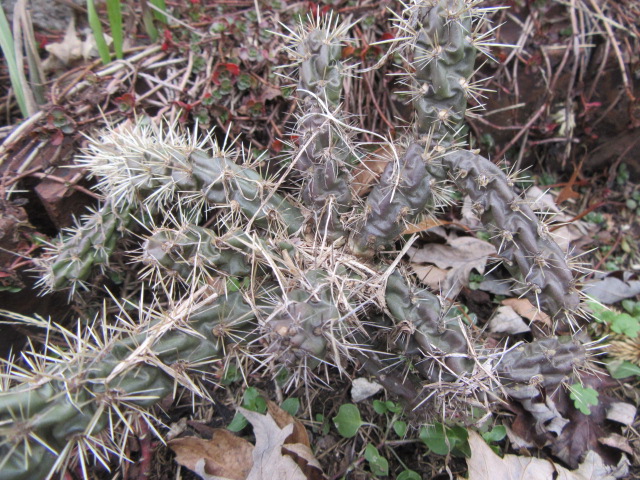
Cylindropuntia imbricata on 12-3-18, #536-1.
Ummm… Since it is winter, the Cylindropuntia imbricata is a little droopy since this one stays outside all year. This has been a very interesting plant since Mrs. Wagler (Wagler’s Greenhouse) gave me a start in 2016. It is always doing something interesting and different. Cylindropuntia imbricata (Haw.) F.M.Knuth was described as such by Frederik Marcus Knuth in Kaktus-ABC in 1935. It was first described as Cereus imbricatus by Adrian Hardy Haworth in Succulent Plantarum Succulentarum in 1819.
You can view this plant’s own page by clicking HERE.
I was at a friend’s mother’s farm today and her Prickly Pear are all flat as a pancake…
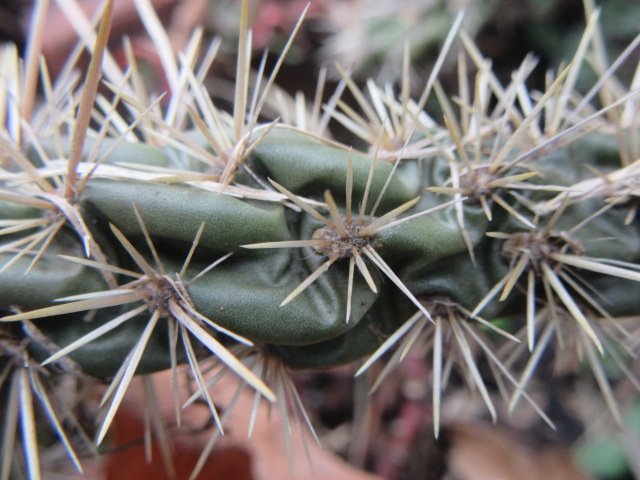
Cylindropuntia imbricata close-up on 12-3-18, #536-2.
The Cylindropuntia imbricata produces leaves from its areoles in the spring and can be very interesting for at least a month. The leaves shed and are replaced by the spines. The stems branch out, sometimes only in one direction, to form a tree-like appearance. The strange-looking elongated tubercles seem to overlap which gave rise to the species name which comes from the Latin verb “imbricere” which means “to tile a roof”. Its areoles are kind of an oval shape from which grow glochids, radial spines, and central spines This is one cactus you definitely want to avoid touching if possible. I get stuck almost every time I cultivate around this plant, pull grass and weeds, or take photos. Every time I get stuck I have a spine or glochid (s) in my skin to pull out. It’s OK because this plant is pretty neat otherwise. I will be glad when it finally flowers for the first time.
—-<<<<+>>>>—-
The Echinocactus and Echinopsis
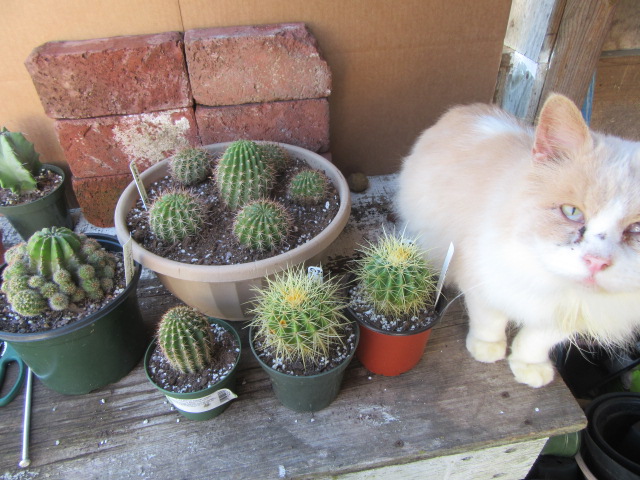
Echinocactus and Echinopsis Group on 11-29-18, #534-7. Plus a cat with no name…
I took photos of the Echinocactus and Echinopsis together but didn’t realize it until I was writing their captions. I either slipped a cog or the cats were confusing me. Trying to keep Susie from going into the house would have been easier if I had closed the door. Then she disappeared so I figured she had gone into the house. I was busy taking photos and didn’t have time to go check at the time. When I did finally go in to see where she was… She was very contently laying on the pillow on my bed as if she was supposed to be there. She didn’t notice I saw her, so I went to get the camera. Well, then she heard me and realized she had been caught pretending she was a princess. She got off the bed and tried the back of the sofa. I don’t get upset so she didn’t get into trouble. I think she was probably a human in a past life because of so many reasons. Then, the “pale yellow” fuzzy tomcat wanted attention. If you touch this guy he won’t leave you alone. He smells bad on top of that. GEEZ! His brother, the dark yellow fuzzy tomcat is just the opposite. He only comes to the porch to eat and will not let you touch him. Once he smelled my finger but that was as far as it went.
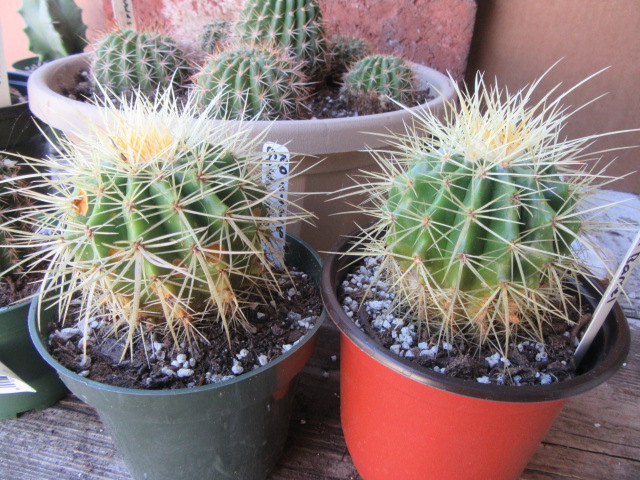
Echinocactus grusonii on 11-29-18, #534-8.
The Echinocactus grusonii is a really neat cactus. Its common name is Golden Barrel Cactus. Echinocactus grusonii Hildm. was named and first documented by H. Hildmann in Deutsche Garten-Zeitung in 1886 and again in Monatsschrift für Kakteenkunde in 1891. You can view this plant’s own page by clicking HERE. There are several varieties and forms of this cactus.
This is a popular species and was one collected in the wild to near extinction.
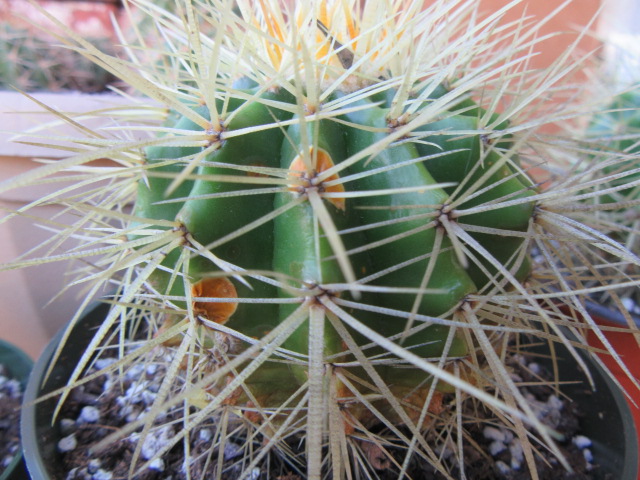
The yellow spots are from cricket damage last year.
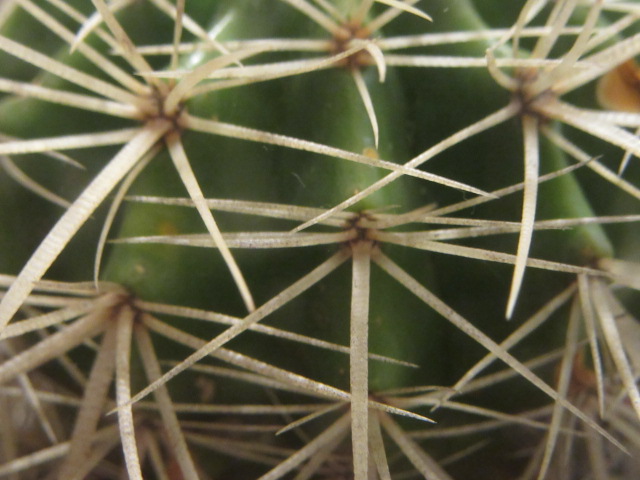
Echinocactus grusonii close-up on 12-1-18, #535-6.
The Echinocactus grusonii gives new meaning to “handle with care”. Its spines are long, very stiff, and sharp. Different varieties and forms of Echinocactus grusonii have different sizes of spines. The only photos I have seen online of spines as long as mine is of the Echinocactus grusonii var. albispinus which have white spines instead of yellow. Umm… The above photo looks like it has white spines, but in person, they look yellow. It makes me wonder, though. Hmmm… Of course, Echinocactus grusonii var. albispinus is considered a synonym of the species now.
I think this is an example of what acicular spines are.
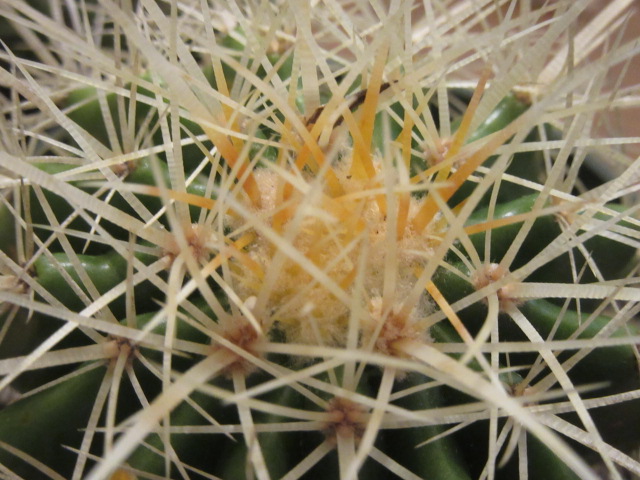
Echinocactus grusonii close-up from the top on 12-1-18, #535-7.
The top of the Echinocactus grusonii is not one you would want to sit on. I read this cactus produces small flowers near the apex that can be hidden by the wool. Oh yeah, I almost forgot to mention that the longest central spines on these two cacti are 1 1/2″ long…

Echinopsis ‘Rainbow Bursts’ on 11-29-18, #534-10.
I purchased this Echinopsis ‘Rainbow Bursts’ on February 1, 2016. The label said it was an x Echinobivia ‘Rainbow Bursts’ which was a cross between an Echinopsis and Lobivia species. Well, species of the Lobivia genus were transferred to Echinopsis. Although it is still a hybrid, it just isn’t an intergeneric hybrid. It is neat how its kids grow from between its areoles. You can view this plant’s page by clicking HERE. Currently, Plants of the World Online lists 68 accepted species of Echinopsis.
This plant was 2 1/4″ tall x 3 1/2″ wide when I brought it home on February 1, 2016, and it measured 3″ tall x 5″ wide on October 10, 2018.

Echinopsis ‘Rainbow Bursts’ close-up of the original plant on 12-1-18, #535-8.
The parent plants areoles have very short spines and small tufts of wool. The hair you see in the photo must be cat fur…

Close-up of the Echinopsis ‘Rainbow Bursts’ offsets on 12-1-18, #535-9.
Very interesting how much different the offsets look than the parent. The offsets grew a lot this past summer.
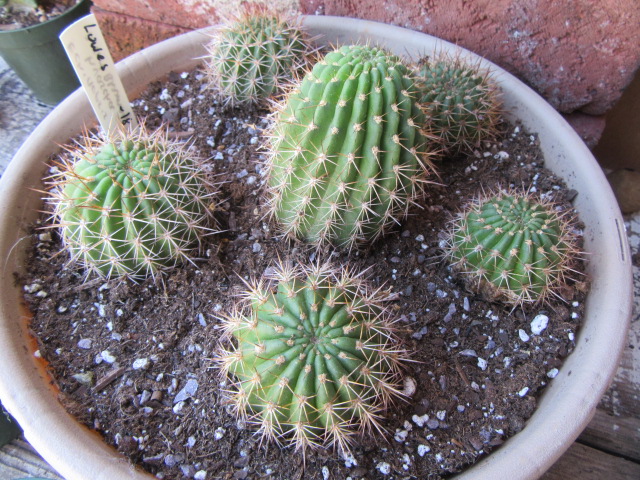
Echinopsis huascha on 11-29-18, #534-11.
Echinopsis huascha is one of those species that has a very confusing taxonomy history. Plants of the World Online currently lists 42 synonyms of this species which cover NINE genera. Six used Cereus huascha F.A.C. Weber as the basionym. It was formerly Cereus huascha F.A.C.Weber as named and described by Frédéric Albert Constantin Weber in Monatsschrift für Kakteenkunde (Berlin) in 1893. It was relocated to the Echinopsis genus by Heimo Friedrich and Gordon Douglas Rowley and renamed Echinopsis huascha (F.A.C.Weber) H.Friedrich & G.D.Rowley in 1974. Its common names are Desert’s Blooming Jewel and Red Torch. You can view this plant’s own page by clicking HERE.
Echinopsis huascha is an upright or sprawling basally branching cactus that can grow up to 36″ tall. They are known for their beautiful flowers that grow about 4″ long and grow on top of the plant. Flowers can be yellow, orange, and red. Echinopsis huascha var. grandiflora only produces red flowers. BUT…
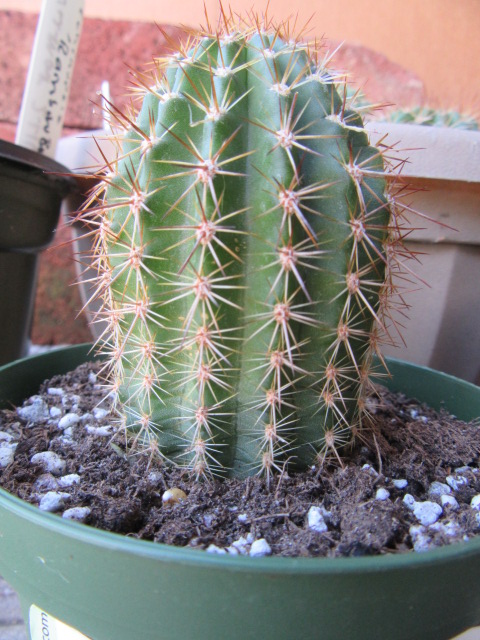
The smaller Echinopsis huascha on 11-29-18 #534-12.
When I was at Lowe’s on September 21, I decided to check the clearance rack for a few cactus I didn’t have. I think I may have gone there for potting soil with cactus as my second reason. Maybe visa versa. I already picked out several small cactus from a clearance rack and while walking around a little I found a BIG pot. The big pot had six good-sized offsets surrounding a bigger dead plant in the center. Well, it was only $5.00, so I brought it home, too. When I came home, to my amazement, the label on the big pot was the same as one of the smaller plants. The label said they were Trichocereus grandiflorus which is now a synonym of Echinopsis huascha. Previously, Echinopsis hybrids were crossed with species of Trichocereus to produced plants that flowered in various colors. Trichocereus is still an accepted genus with 14 species.
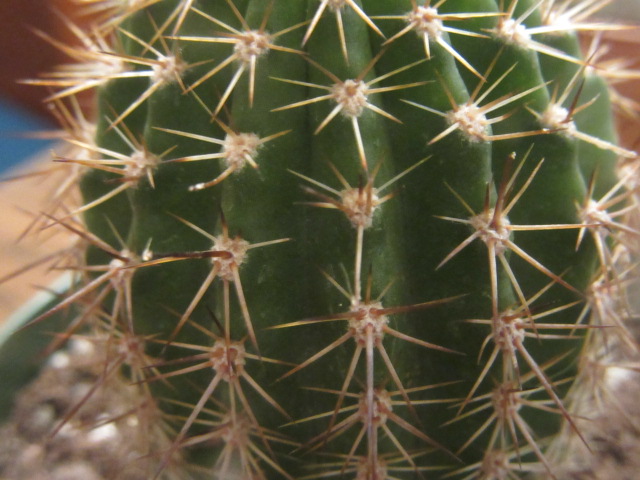
Echinopsis huascha close-up on 12-1-18, #535-10.
The species is “variable” and some photos show plants with longer spines. According to the Llifle (encyclopedia of Living Forms), the species can have spines as long as 5-6 cm., which is about 2-1 1/4″. Echinopsis huascha var. grandiflora grow shorter spines, around 1 cm., which is less than 1/4″. However, variety name isn’t accepted and is considered a synonym of Echinopsis huascha… Well, from the description and in my opinion, my Echinopsis huascha are the variety grandiflora. BUT… According to Llifle, Echinopsis huascha var. grandiflora was originally Lobivia grandiflora (Britton & Rose 1922). Plants of the World Online says Lobivia grandiflora is a synonym of Echinopsis rowley… Something is weird because Llifle says Lobivia grandiflora and Echinopsis rowley are both synonyms of Echinopsis huascha… Well, maybe Llifle isn’t up-to-date or they have their own opinion (or their sources aren’t up-to-date). Maybe Plants of the World Online is incorrect and doesn’t know it. Maybe I will change the name to Echinopsis huascha var. grandiflora and wait for that name to be accepted.
At some point, I hope the botanists “in charge” of what is and isn’t accepted will realize the need to “accept” the many varieties, forms, subspecies, etc. which further identifies the plants based on specific characteristics. I think it has to happen to avoid confusion and but maybe they think the opposite. POWO doesn’t even list Echinopsis huascha var. grandiflora period… Neither does The Plant List (from 2013), Tropicos OR EVEN IPNI (International Plant Names Index. Hmmm… We shall find out for sure when these plants flower since there are seven…
—-<<<<+>>>>—-
Espostoa melanostele
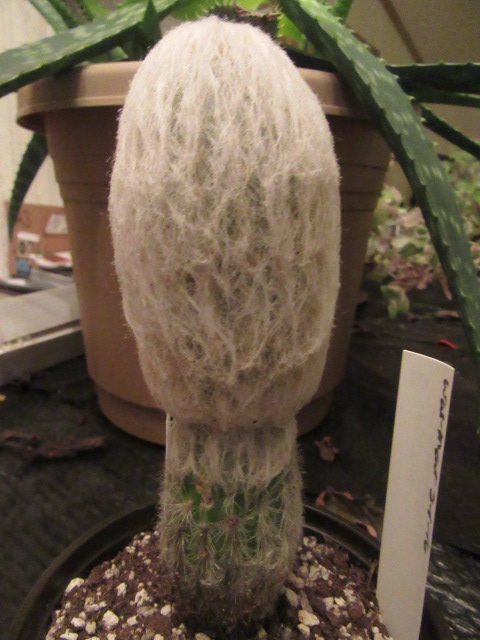
Espostoa melanostele subsp. nana on 11-29-18, #534-13.
I keep looking for a face and ears on this Espostoa melanostele subsp. nana (Peruvian Old Lady) but so far I have found none. Although the label with this plant just said Espostoa melanostele, the species has yellow-brown wool while the subspecies has white to pale yellow.
Espostoa melanostele subsp. nana (F.Ritter) G.J.Charles is an accepted infraspecific name for this species. It was described as such by Graham Charles in Cactaceae Systematics Initiatives in 2002. It was first named and described as a separate species, Espostoa nana F.Ritter by Friedrich Ritter in Taxon in 1964. The species, Espostoa melanostele (Vaupel) Borg, was named and described by John Borg in Cacti in 1937. It was first named Cephalocereus melanostele Vaupel and described by Friedrich Karl Johann Vaupel in Botanische Jahrbuecher fuer Systematik in 1913. Plants of the World Online currently lists 11 accepted species in the Espostoa genus.
You can view this plant’s own page by clicking HERE.
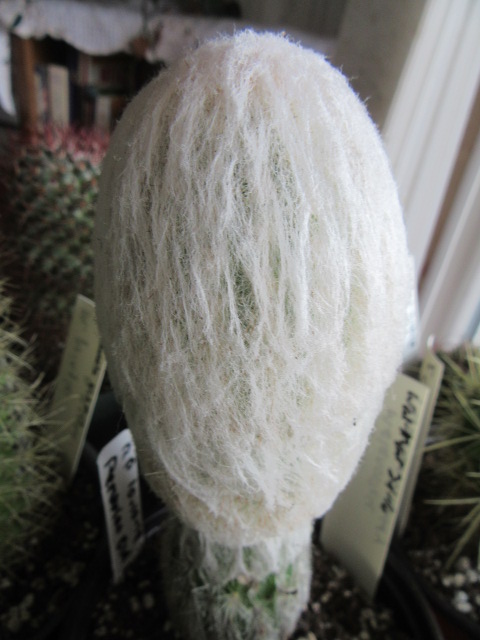
Espostoa melanostele subsp. nana close-up on 11-29-18, #534-14.
Under all that hair is a columnar cactus with numerous areoles with around 30 short radial spines each! While it may look soft to the touch, there are also many very thin central spines so you still need to handle with care.
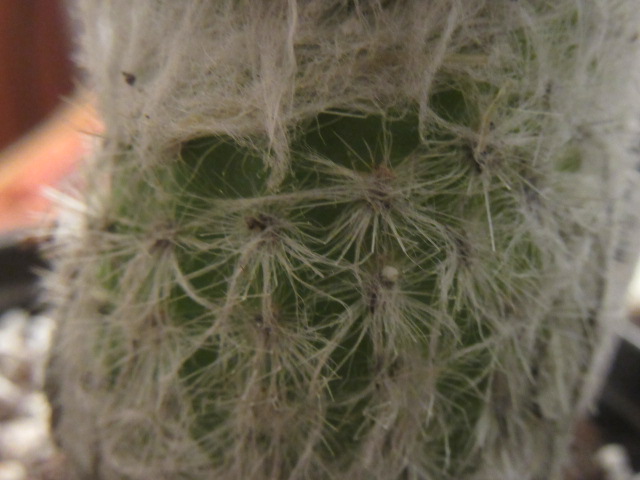
Espostoa melanostele subsp. nana close-up on 12-6-18, #537-1.
When I read the areoles of the Espostoa melanostele subsp. nana had that many spines I had to go get it and see for myself. I looked at the lower part of the cactus where there wasn’t as much hair. WOW!
This plant has grown quite a bit and was 6 1/4″ tall x 2 5/8″ wide when I measured it on October 10. That is 7/8″ taller and 5/8″ wider than last year when it was measured on 10-17-17. When I bought this plant on February 1, 2016, it only measured 2 3/4″ tall x 1 3/4″ wide.
—-<<<<+>>>>—-
The Mammillaria Group
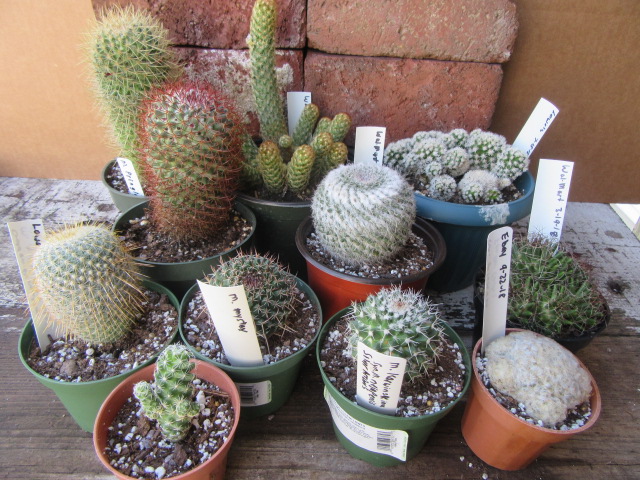
The Mammillaria Group on 11-29-18, #534-15.
So far I have 11 different Mammillaria. I have had a couple of others in the past that died, but for the most part, Mammillaria species are very popular and easy to grow. They all have the characteristic tubercles that resemble “nipples”. Mammillaria is a very diverse and somewhat variable species. I am beginning to dislike the word “variable” when it comes to plant ID. The tubercles on Mammillaria species are generally perfectly arranged, many in a spiral pattern. The genus Mammillaria Haw. was named and described by Adrian Hardy Haworth in Synopsis Plantarum Succulentarum in 1812. According to Plants of the World Online, there are currently 162 accepted Mammillaria species which doesn’t even begin to mention all the infraspecific names (forms, varieties, and subspecies), accepted or not. Plants you find at Lowe’s, Wal-Mart, Home Depot, or other garden centers are just a drop in the bucket. You can find a much larger variety on Facebook groups and Ebay. There are also several very good online sources, especially nurseries that specialize in cactus.
Many Mammillaria species tubercles grow in two sets of intersecting spirals (known as phyllotactic spirals). Well, the scientific description from a website I can’t remember said, “Spine clusters occur in two sets of intersecting spirals (phyllotactic spirals). Because spines develop from primordia produced by auxiliary bud apical meristems, we would expect that each spine in each cluster would also be located at intersections of phyllotactic spirals.” What?
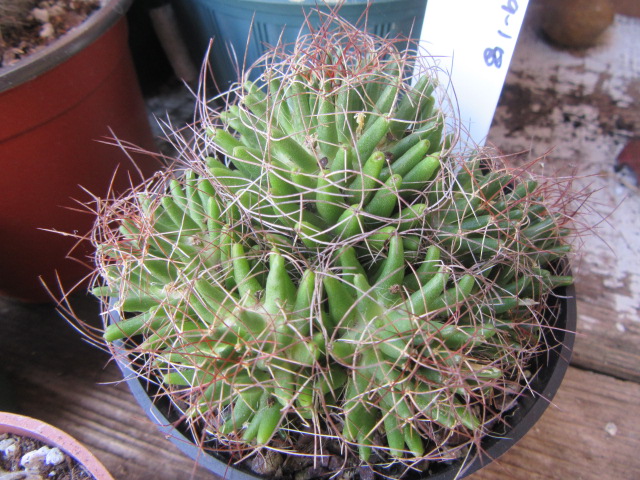
Mammillaria decipiens on 11-29-18, #534-16.
I have only had this Mammillaria decipiens (Bird’s Nest Pincushion) for a companion since March 19 (2018) when I found it at Wal-Mart. It certainly has not been a disappointment. Mammillaria decipiens Scheidw. was named and described by Michael Joseph François Scheidweiler in Bulletins de l’Académie Royale des Sciences et Belles in 1839. There are a few other subspecies, but currently, they are considered synonyms of the species. (Except for one which was moved to another genus). My plant is actually Mammillaria decipiens subsp. camptotricha (Dams) D.R.Hunt but that name is considered a synonym of Mammillaria decipiens by Plants of the World Online. It was formerly Mammillaria camptotricha… There are 19 synonyms of Mammillaria decipiens listed in Plants of the World Online. Oh yeah! I almost forgot I can use any name I want as long as it was validly published… It was validly published by David Richard Hunt in Mammillaria Postscripts in 1997.
You can view this plant’s own page by clicking HERE.
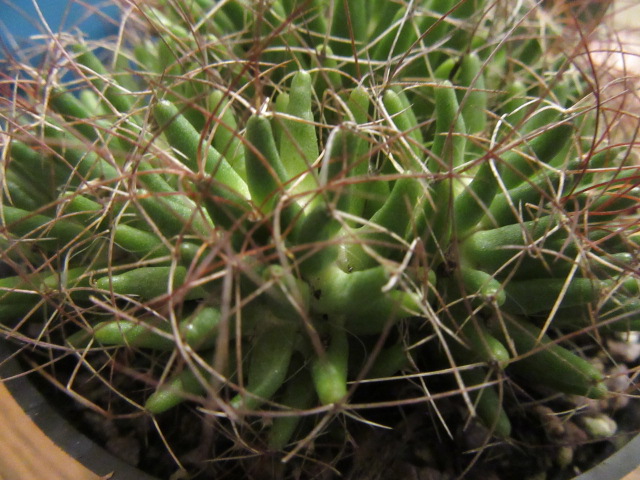
Mammillaria decipiens subsp. camptotricha close-up on 12-1-18, #535-11.
Mammillaria decipiens subsp. camptotricha has very prominent tubercles and long spines which cover the entire plant (on more mature specimens). The species and other subspecies do not have these long radial spines, and this one in particular usually lack central spines. As you can clearly see, my plant has long radial spines with no central spines, and, nice nipples. Sorry, I mean tubercles. 🙂
When I brought this plant home, it measured 1 1/2″ tall x 3″ wide. When I measured the cactus on October 10, it measured 1 5/8″ tall x 3 3/4″ wide. It flowered nonstop over several months. When re-potting, I also found it has a good-sized root system…
I believe at some point the infraspecific names will be revisited and approved AGAIN… So, I just as well get a head start and “re-name” this plant while I don’t have so any captions to change. 🙂
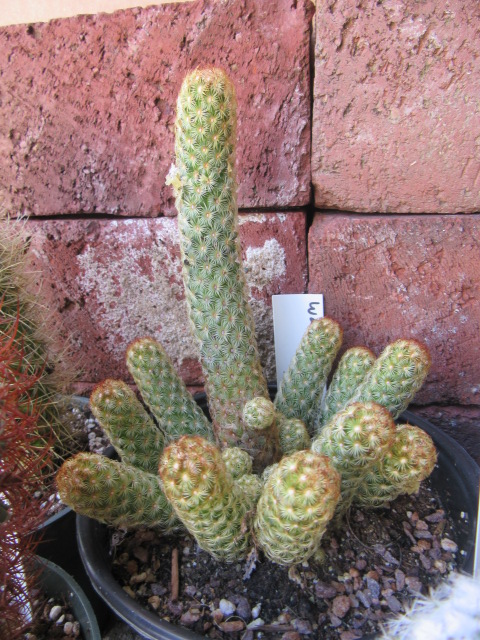
Mammillaria elongata on 11-29-18, #534-17.
The Mammillaria elongata is simply weird. Not long after I brought it home on March 19 I accidentally knocked it off the table and all but two of the offsets fell off. I just stuck them back in the pot and hoped for the best. When spring came I took the plants back outside and repotted this plant. Next thing I knew the original plant was sending out new offsets. At one point, the main plant was laying down then it stood back up again. It seemed when it was in full sun and happy it laid down but when I brought it inside it stood up and started going toward the light. Hmmm… You can view this plant’s own page by clicking HERE.
Mammillaria elongata DC. is the correct and accepted scientific name of this cactus. It was named and described by Augustin Pyramus de Candolle in Mémoires du Museum d’Histoire Naturelle (Paris) in 1828.
There are 11 larger offsets averaging 2 1/4″ long and 15 small offsets. One of the larger offsets also has 2. The original stem is 6 1/4″ tall (or long) which was 5 3/4″ tall when I brought it home. Re-potting this plant was not easy…
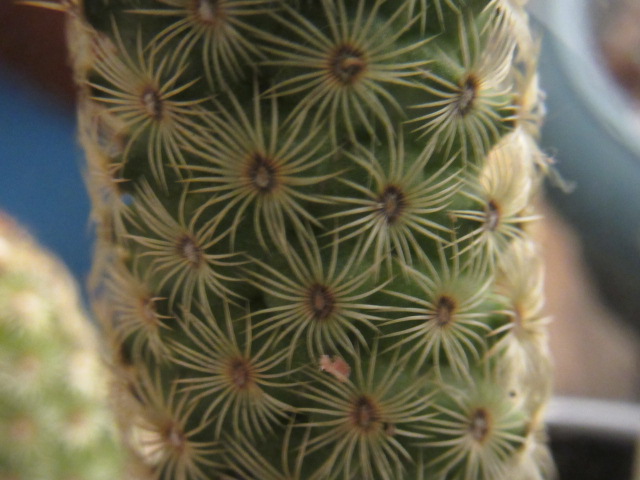
Mammillaria elongata close-up on 12-1-18, #535-12.
Now, that photo came out very good! I counted twenty-six radial spines, more or less, re-curved, white to yellowish. Central spines are usually absent on MOST areoles. They look more like flowers than a spiny areole. You can actually put your hand around the stems, which is when you find the central spines. Then they will be in your fingers and not on the cactus.
According to Llifle, this may be the most common Mammillaria species and occurs in more variations than any other species in the genus (including color and spine variations). Stems can be erect, ascending, prostrate, or recumbent.
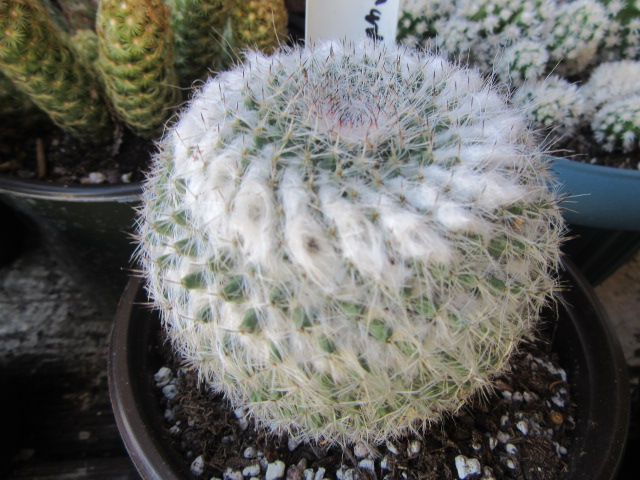
Mammillaria hahniana on 11-29-18, #534-18.
The Mammillaria hahniana (Old Lady Cactus/Old Lady Pincushion) is always interesting. You can definitely tell its tubercles are in a spiral pattern because its wool looks like it has been outside in the wind.
Mammillaria hahniana Werderm. is the correct and accepted scientific name for this species of Mammillaria. It was named and described by Erich Werdermann in Monatsschrift der Deutschen Kakteen-Gesellschaft (Berlin) in 1929.
This plant produces many flowers in a circular pattern around the top part of the stem. You can view this plant’s own page by clicking HERE.
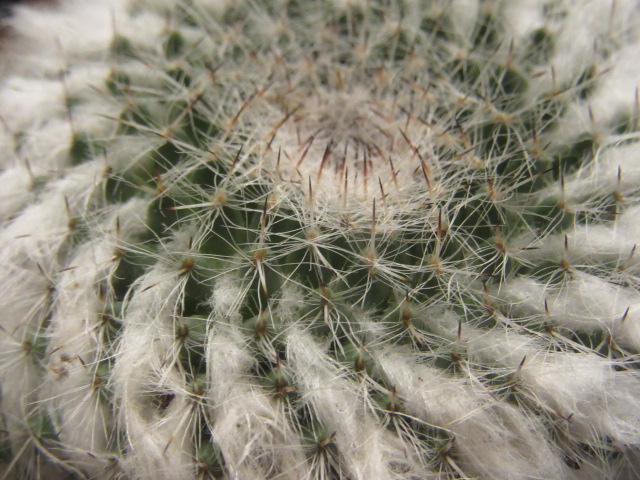
Mammillaria hahniana close-up of the apex on 12-1-18, #535-13.
The apex is in the center of the top of the plant. Many Mammillaria species apex is kind of concave. The axil, I think, is either the lowest part or where it starts to angle up. There are 20-30 spines in this area that appear to “unfold” as the plant grows. Be it ever so sssssllllloooowwwwllllyyyy…
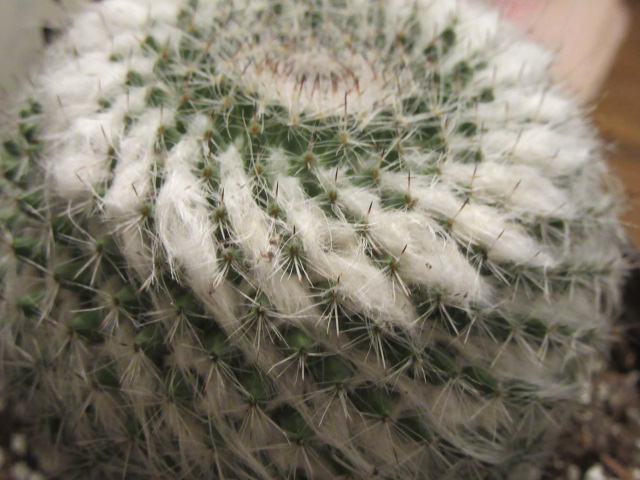
Mammillaria hahniana close-up on 12-1-18, #535-14.
Its white hair can cover the entire plant and increases in thickness and length as the plant ages. Each tubercle has 1-4 small central spines and 20-30 hair-like radial spines. Some specimens may not even have radial spines. Some Mammillaria species have latex in their tubercles and this one supposedly does…
This plant measured 1 7/8” tall x 2 3/8” wide when I brought it home on February 1, 2016. On October 10, it measured 2 5/8″ tall x 2 7/8″ wide.
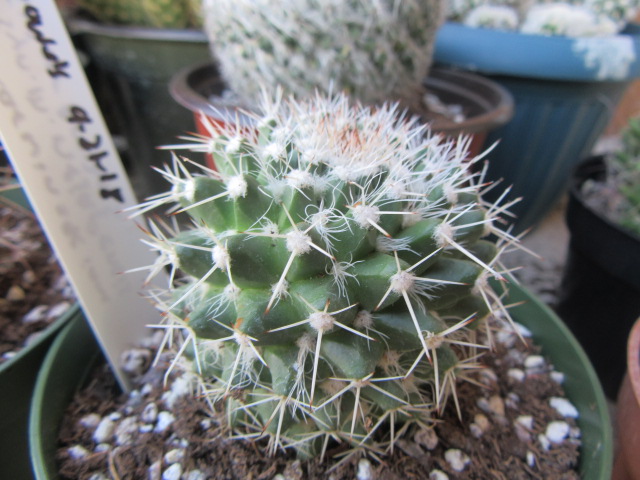
Mammillaria karwinskiana on 11-29-18, #534-19.
The Mammillaria karwinskiana (Silver Arrows) was labeled Mammillaria nejapensis which is now a synonym. It was named and described by Carl (Karl) Friedrich Philipp von Martius in Nova Acta Physico-Medica… in 1832.
I brought this plant home on September 21 so it is still small at 1 7/8″ tall x 2 1/8″ wide (not including the spines). This plant will definitely be interesting to watch as it gets older. To view this plant’s own page click HERE.
I had mentioned in an earlier post, when I brought it home, this species is just one of a few Mammillaria that are known as “Owls Eye Cactus”. They are known for their dichotomous branching (forking or dividing into two parts). Dichotomous branching is not common in cacti in general, but it happens with certain species. When I first found out about “Owl’s Eye Cactus” and dichotomous branching in cactus, I thought it was a rarity. Since then, I have discovered MANY of the cactus in my small collection are dichotomous branching. I am not sure if all of them are considered “Owl’s Eye Cactus”, but that name is also a common name for a couple of species.
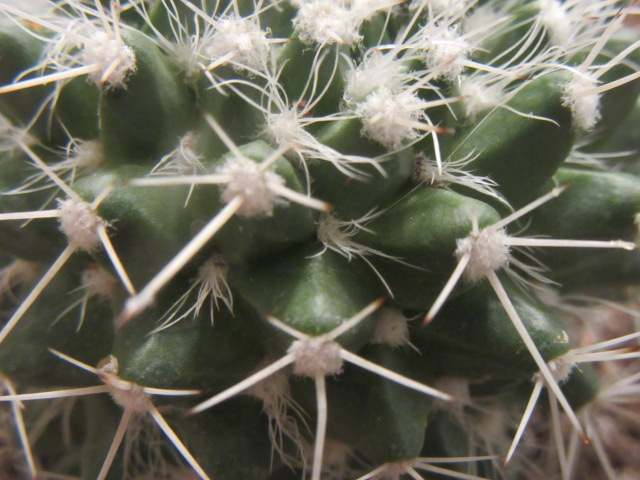
Mammillaria karwinskiana close-up on 12-1-18, #535-15.
Mammillaria karwinskiana differs from the four subspecies (which aren’t accepted names at the moment) because it lacks a central spine. Even though the photo looks like there are five radial spines there are actually six (I counted to make sure). The description of this plant on Llifle taught me a lot of new words… I looked up the words on the CactiGuide Glossary of Cacti Terms then looked at the plant to figure out what it was talking about. 🙂 Then I realized I have been spelling the website name wrong for FIVE years.
Anyway… It says, “The axil is very woolly, with tufts of white hair and long white bristles.” This is talking about the top of the plant. I think the “bristles”, which are stiffened hair (according to CactiGuide), become the radial spines. Not sure, though, because I didn’t notice any long white bristles on this plant. Maybe with age… It also says the tubercles are, “Firm, pyramidal, arranged spirally with 13-21 parastichys.” Hmmm… According to the glossary of terms, a parastichy is a secondary spiral in phyllotaxis. GEEZ! What is a phyllotaxis? It says, “Phyllotaxis is a mode of arrangement of leaves in relation to axis.” WHAT? LEAVES?!?! WHAT LEAVES? Well, with cactus, leaves have been replaced by spines. The tufts of hair (trichomes) between the tubercles are interesting, though, as is the wool on the tips of the nipples. WHOOPS! I mean tubercles…
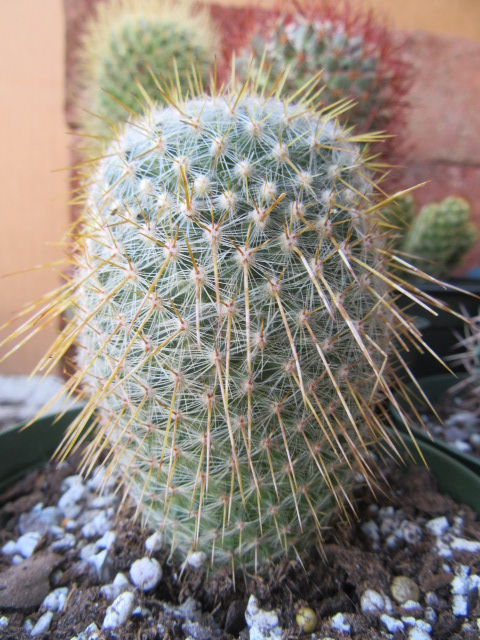
Mammillaria muehlenpfordtii on 11-29-18, #534-20.
The Mammillaria muehlenpfordtii (Golden Pincushion) is another Mammillaria that divides dichotomously (Owl’s Eye Cactus) I bought on the last trip to Lowe’s. The label said it was a Mammillaria celsiana which is a synonym of Mammillaria muehlenpfordtii. The synonym is much easier to write and pronounce… Even Dave’s Garden doesn’t have a pronunciation! It was named and described by Carl Friedrich Förster in Allgemeine Gartenzeitung in 1847.
Llifle says, “Mammillaria muehlenpfordtii is a massive globose cactus with bright carmine flowers. It is solitary when young, but each single stem begins to divide dichotomously to form two stems as it matures, this process repeats several times giving rise to small clustered groups and occasionally to large mounds with dozens of heads. Seen from above the central whorl of woolly areoles resembles a sunflower head.”
You can view this plant’s own page by clicking HERE.
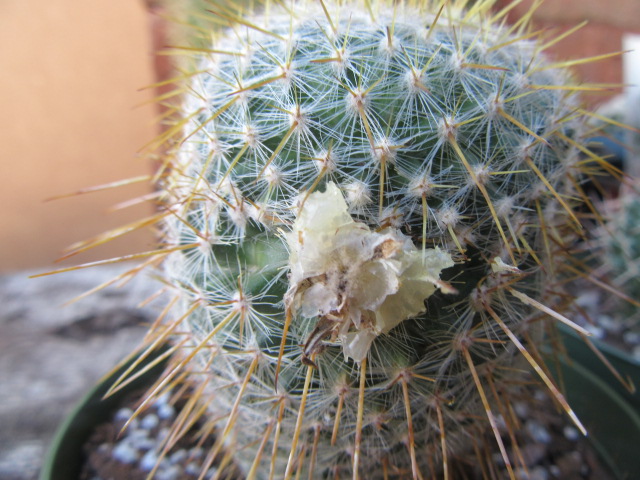
Mammillaria muehlenpfordtii scarred for life. Photo taken on 11-29-18, #534-21.
Sometimes when the “strawflowers” are hot glued to the cactus spines is comes off fairly easily. I have had several plants, like this one, where the glue is put on in a big glob and is stuck tight to the “skin”. I can’t see any selling point the growers are trying to make because anyone can clearly see the flowers are fake. This plant, like several others in my collection, is scarred for life. I always snip off the fake petals down to the glue, if possible without cutting into its spines, and give a gentle pull to see if the glue will come off easily. If not, I just leave it alone hoping time will allow it to come off. This plant was already scarred when I brought it home.
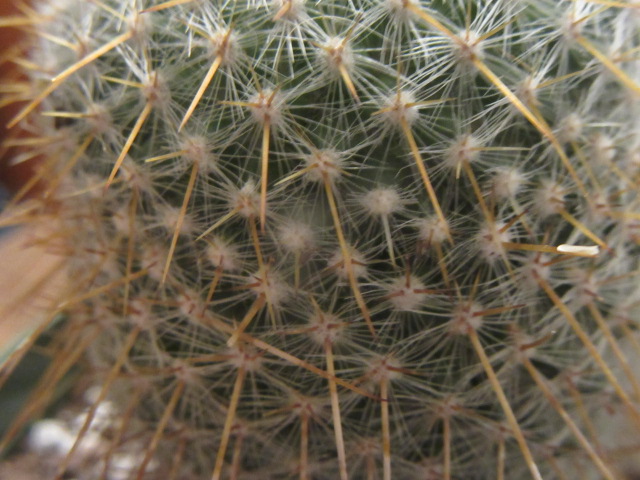
Mammillaria muehlenpfordtii close-up on 12-1-18, #535-16.
The Mammillaria muehlenpfordtii is well armored indeed with 24 to 50 thin radial spines and at least 4 (3-7) central spines. All but one of the central spines are very short while one is very long and points downward. The tubercles on this species do not contain latex. The areoles also have a tiny tuft of wool.
This plant is still small at 3 1/4” tall x 2 1/8” wide without the spines.
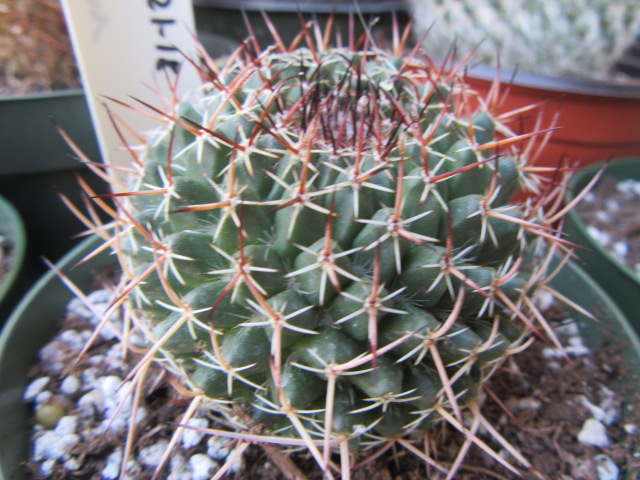
Mammillaria mystax on 11-29-18, #535-22.
The Mammillaria mystax is another Owl’s Eye Cactus that divides dichotomically I brought home from Lowe’s in September. Mammillaria mystax Mart. was named and described by Carl (Karl) Friedrich Philipp von Martius in Hortus Regius Monacensis in 1829. Plants of the World Online lists 27 synonyms of Mammillaria mystax.
This one may get a little wild looking in time… In nature, maybe as a mature specimen, this plant becomes completely entangled with its central spines which can grow up to 2 1/2-3″ long. To bad, but Llifle says this rarely happens in captivity… Information online about this plant’s mature size is varied, anywhere from 6-12″.
You can view this plant’s own page by clicking HERE.
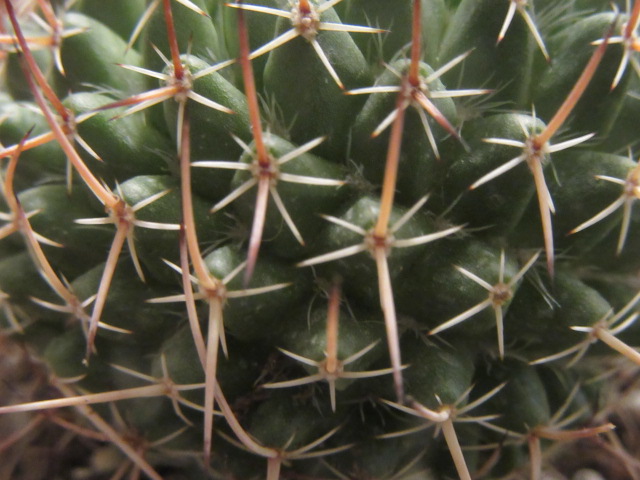
Mammillaria mystax close-up on 12-1-18, #535-17.
Mammillaria mystax can have 3 to 10 radial spines and 1 to 4 central spines. Central spines are normally twice the length as radials, of which one is very long. Llifle says the tubercles are “full of milk which freely flows if pricked or cut.” Weird the description on Llifle says “milk” instead of latex. Hmmm… Notice the “hair” between the tubercles… I think the hair is called trichomes.
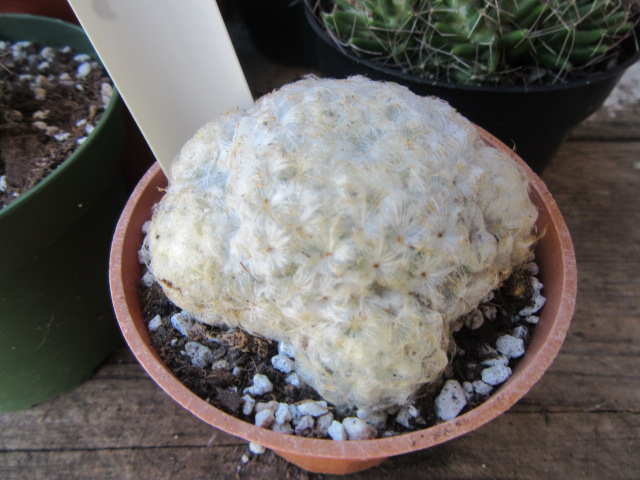
Mammillaria plumosa on 11-29-18, #534-23.
When I was browsing the cactus on Ebay I ran across this Mammillaria plumosa (Feather Cactus). Well, I just had to have one. 🙂 Mammillaria plumosa F.A.C.Weber is the correct and accepted scientific name for this species of cactus. It was named and described by Frédéric Albert Constantin Weber in Dictionnaire d’Horticulture in 1898. It is one of several Mammillaria species to have attained the Royal Horticultural Society’s Award of Garden Merit.
Mammillaria plumosa forms clumps around 15″ wide. It sort of reminds me of a Mammillaria vetula subsp. gracilis covered with feathers.
This cluster of plants has one central plant 1 1/2- 1 3/4″ (depending on where you measure), with six offsets. You can view this plant’s own page by clicking HERE.
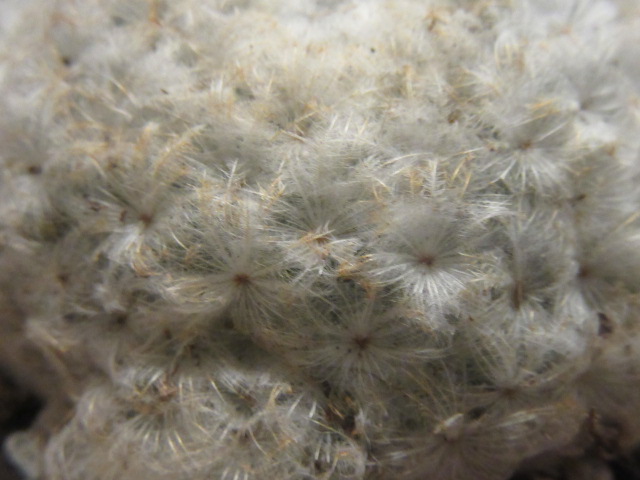
Mammillaria plumosa close-up on 12-1-18, #535-18.
The areole of the Mammillaria plumosa produces about 40 radial spines that are from 1-7 mm long. I think that is up to about 1/32″. Anyway, the radial spines are very short that somehow are interlacing and feathery. Llifle says, “The spines in this species have very long hairs along the spine-axis arranged as are the segments of a bird’s feather and that furnish an epidermal protection against the blasting sun of the desert.” Another more complicated website says, “Epidermis cells on spines of Mammillaria plumosa grow out as trichomes, shading the plant.” I think they misspelled trichomes…
OK, in layman’s terms… I looked at the plant closely with a magnifying glass and it was still fairly difficult to see what is going on because everything is so small. The tubercles are fairly close together so the radial spines kind of interlace with each other. The radial spines, even though Llifle says they are 1-7 mm long, some of them measured 1/8″ long and are pretty stiff. Even though they are thin and stringy looking, they are more like a very thin wire. Very few resemble feathers, BUT if you look closely at the above photo you can actually see a few in this photo that does look like feathers… It is hard to tell where the hair (trichomes) comes from but Llifle says the spine axis. That would mean also from the areole since that is where the spines grow from. The wooliest areas are around the apex and feel like cotton. Oh yeah… The brown spots in the photo are the centers of the areoles. It is going to be neat watching this plant grow.
By the time I was finished looking the plant over, it was telling me, “ENOUGH ALREADY!”
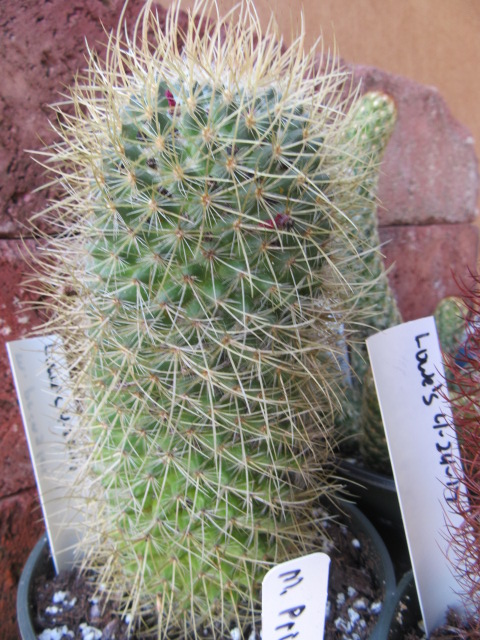
Mammillaria pringlei on 11-29-18, #534-25.
Now, for the Mammillaria pringlei (Lemon Ball Cactus)… Mammillaria pringlei (J.M.Coult.) K.Brandegee was named and described by Mary Katherine Brandegee in Zoe in 1900. It was first named and described as Cactus pringlei by John Merle Coulter in Contributions from the United States National Herbarium (Smithsonian Institution) in 1894. Many websites and databases say Mammillaria pringlei is a subspecies of Mammillaria rhodantha but they may not be up-to-date. According to some, Mammillaria pringlei is one of many golden and yellow-amber spined variants of Mammillaria rhodantha. I am sticking with what Plants of the World Online by Kew say because I think they are the most up-to-date. I am also tired of changing names only to have to change them back again later.
I have have had this Mammillaria pringlei as a companion since April 24, 2017, when I brought it home from Lowe’s. It has been a great plant and is a profuse bloomer. To view this plant’s own page click HERE. Sometimes it is a bit of a leaner. I stand it back up when I re-pot it and it leans AGAIN… Then I realized all I have to do is turn the pot around. It always leans toward the south.
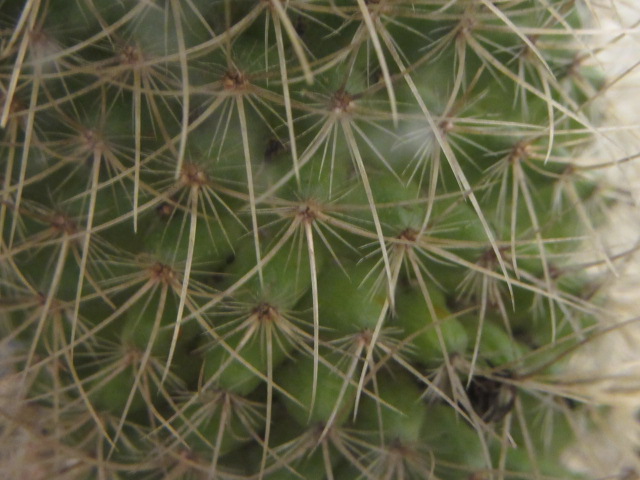
Mammillaria pringlei close-up on 12-1-18, #535-19.
Mammillaria pringlei is one of only a few species that have glowing golden spines. It has 18-22 radial spines and 5-7 central spines that are somewhat re-curved. Information says it is generally a solitary ball cactus that eventually divides dichotomously.
On October 10 when I re-potted this cactus and measured it, I wrote down that it was 4 7/8 ” tall x 2″ wide (without the spines). As I was writing this on November 9, I was thinking it was bigger so I went to measure it again. This time it is 5 3/4″ tall x 2 1/2″ wide (without the spines). So, did it grow 7/8″ in a month while inside? Last year I screwed up and included the spines in their measurements so out of curiosity I measured it with the spines. Including the spines, it is currently 6 1/8″ tall x 3 1/2″ wide. Last year it was 4 1/2″ tall and 3 1/2″ wide with the spines… GEEZ! That is 1 5/8″ taller and the same width.
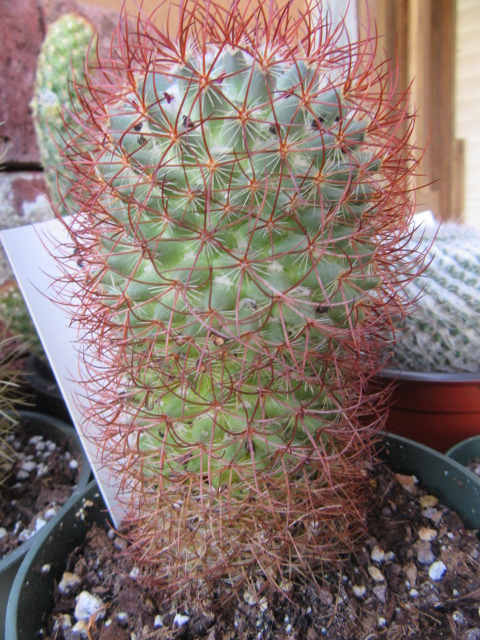
Mammillaria rhodantha on 11-29-18, #534-26.
Next in the alphabet is the red-headed Mammillaria rhodantha (Rainbow Pincushion). Mammillaria rhodantha Link & Otto is the correct and accepted scientific name of this plant. It was first described by Johann Heinrich Friedrich Link AND Christoph Friedrich Otto in Icones Plantarum Selectarum in 1828. Plants of the World Online lists a WHOPPING 115 synonyms of this plant, probably because it is so variable. 28 of those synonyms are subspecies or varieties of Mammillaria rhodantha. Some databases still include those synonyms as valid as with Mammillaria pringlei.
I brought this plant home from Wal-Mart on February 1, 2016, and it has always been enjoyable. You can view this plant’s own page by clicking HERE.
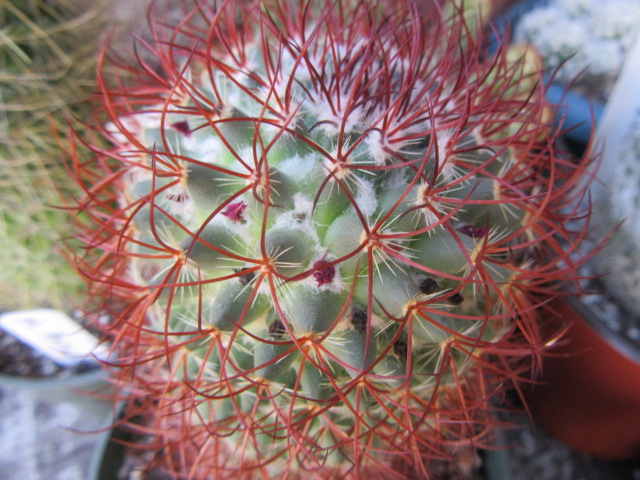
Mammillaria rhodantha buds on 11-29-18, #534-27.
It takes a LONG time for the buds to open on this plant… Buds form in the axils between the tubercles from the previous year’s growth. There is also a little wool in the axils between the tubercles which disappears with age. Supposedly, maybe on some species, flowering doesn’t occur until after the growth of the trichomes becomes inactive. Here you see buds forming among the wool between some of the tubercles…
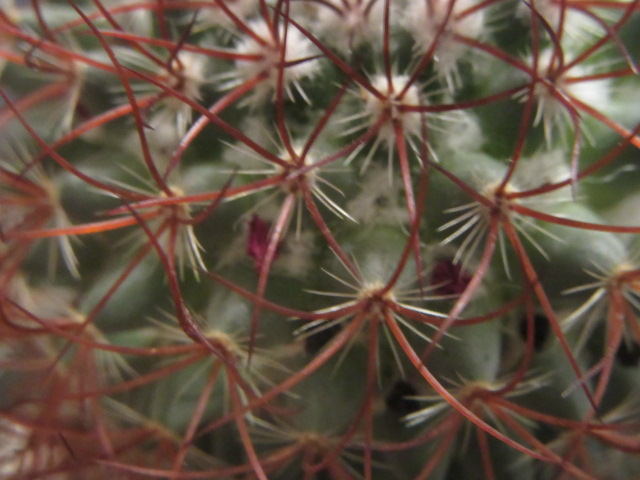
Mammillaria rhodantha close-up on 12-1-18, #535-20.
This Mammillaria rhodantha has 4-9 long, reddish-brown, recurving central spines. Other variations do not have reddish-brown spines. It produces 16-24 white (sometimes yellowish) radial spines.
The radial spines on the lower plant can turn somewhat gray looking with age, which Llifle says appear to be dying.
Mammillaria rhodantha divides dichotomously and also produces offsets. Hmmm… I didn’t realize I had so many Mammillaria species that divide dichotomously…
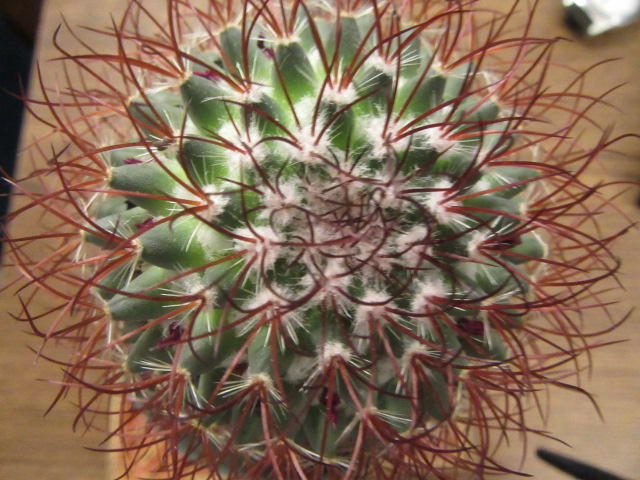
Mammillaria rhodantha from the top on 12-10-18, #538-1.
I took a photo of the top part of this cactus because it is very interesting. Many species have a wooly apex but the Mammillaria rhodantha is especially colorful. The wool on the areoles pretty much disappears as the plant ages.
When I measured the cactus on October 10, this plant was 4″ tall x 2 7/16″ wide. Since the Mammillaria pringlei was taller after only a month, I decided to re-measure this one, too. HOLY CRAP! It is now 4 1/2″ tall! Something is definitely weird! I checked several others and they are the same. How could… I don’t want to think about it…
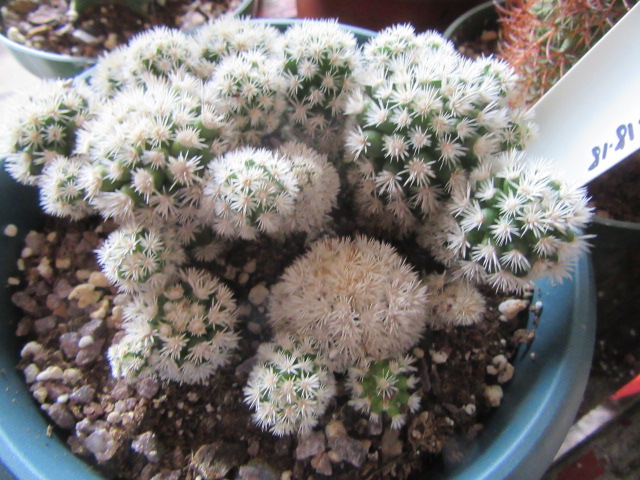
Mammillaria vetula subsp. gracilis ‘Arizona Snowcap’ on 11-29-18, #534-28
I found this Mammillaria vetula subsp. gracilis ‘Arizona Snowcap’ at Lowe’s on July 18. The label said Mammillaria gracilis fragilis monstrose which is partly true. Mammillaria gracilis var. fragilis is a synonym of Mammillaria vetula subsp. gracilis. Actually, Plants of the World online says the later is a synonym of Mammillaria vetula but, and here we go again, I think eventually they will come around and list the subspecies as accepted. They are still uploading data… The websites and databases that are not up-to-date are still saying Mammillaria gracilis var. fragilis… Mammillaria vetula subsp. gracilis (Pfeiff.) D.R.Hunt is the correct and accepted name for this subspecies of Mammillaria vetula. I was named and described by David Richard Hunt in Mammillaria Postscripts in 1997.
The cultivar, ‘Arizona Snowcap’, IS a monstrous form of Mammillaria vetula subsp. gracilis. Llifle says “it looks so different from the wild species that it isn’t easy to realize they are related.”
You can view this plant’s own page by clicking HERE.
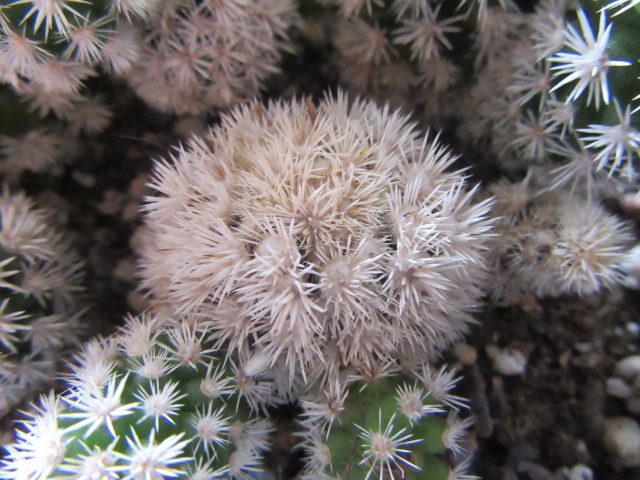
Mammillaria vetula subsp. gracilis ‘Arizona Snowcap’ on 11-29-18, #534-29.
I had a Mammillaria vetula subsp. gracilis before that was much different. When I first brought this plant home none of the offsets were as thickly covered as a few are now but I still knew it was different than the previous one. In fact, there was one next to it at Lowe’s when I found this one. I have no idea why only a few offsets spines are thicker and the others aren’t.
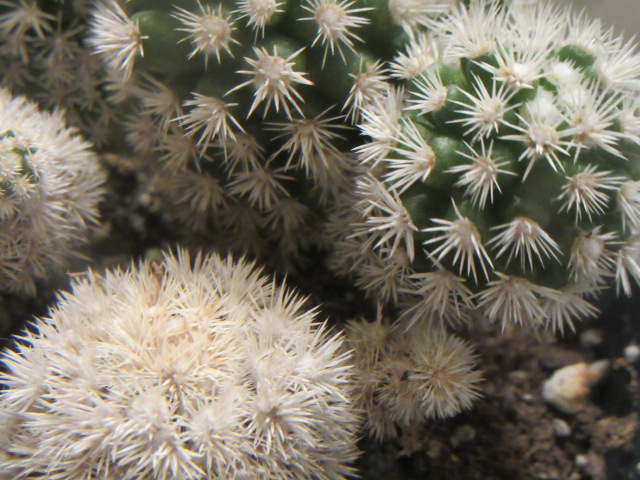
Mammillaria vetula subsp. gracilis ‘Arizona Snowcap’ close-up on 12-1-18, #535-21.
The species, Mammillaria vetula, has 1-2 central spines and at least 25 radial spines. The subspecies often lack the central spines and only has 11-16 radial spines. The plant I had before also had much longer spines. Its flowers are also shorter. I noticed the areoles on the top have a small tuft of wool but not so much on the lower parts. It is hard to tell if this plant has central spines.
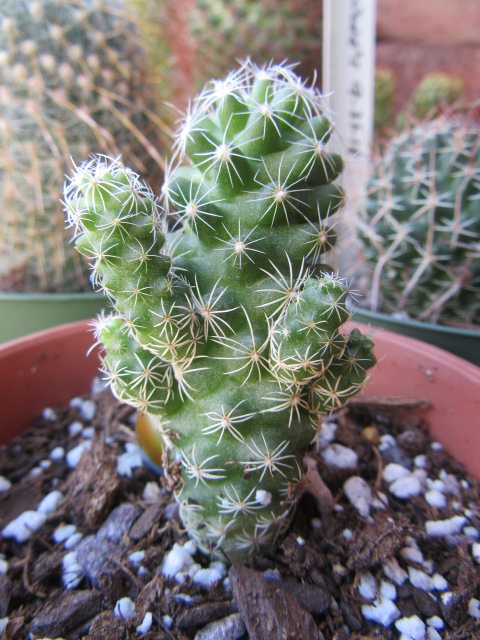
Mammillaria vetula subsp. gracilis on 11-29-18, #534-30.
This plant MAY BE a Mammillaria vetula var. gracilis. OK, I found this cactus at Wagler’s Greenhouse this past summer. It was unlabeled but I pretty much knew it was a Mammillaria. I wasn’t sure of the species so I had to do a little research. After a while, I decided I better get some help from the Mammillaria Group on Facebook. A member promptly replied that it was a Mammillaria gracilis var. fragilis and another said it was a Thimble Cactus. Well, to me, this plant didn’t look like what they said. A few weeks ago I posted a more recent photo and I received the same answer. This time, I corrected the member and told him that Mammillaria gracilis var. fragilis was a synonym of Mammillaria vetula subsp. gracilis. Ummm… He didn’t answer back or even click “like”. 🙂 I think I need to stop doing that.
I supposed it was possible and even probable this plant could be a Mammillaria vetula subsp. gracilis so I went ahead and changed the captions on its previous photos. They were labeled “Unknown Cactus”.
If you would like to see the Mammillaria vetula subsp. gracilis I had before, you can click HERE.
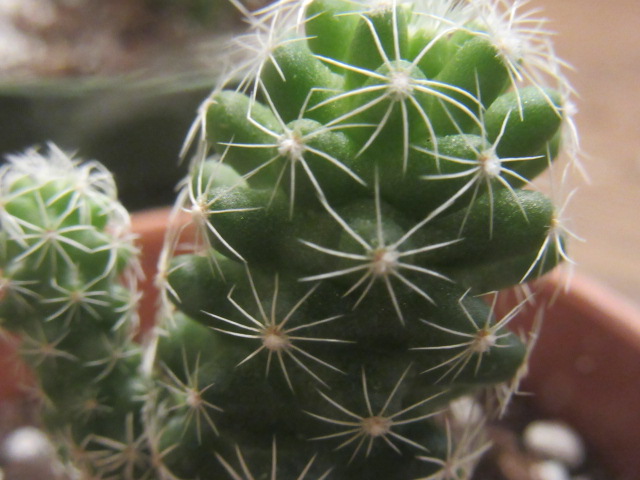
Mammillaria vetula subsp. gracilis close-up on 12-1-18, #535-22.
It does have the correct amount of radial spines and lacks the central spine. BUT… This plant is 2 1/4″ tall! Plus it is growing offsets from the stem instead of from the bottom so how could it be a Thimble Cactus? But guess what? I looked at the old photos of the Mammillaria vetula subsp. gracilis from 2014 and it was doing the same exact thing… So, I guess that settles it. By the way, the other one was my first Mammillaria.
That is all of the Mammillaria for now… Until I add more. 🙂
—-<<<<+>>>>—-
Parodia lenninghausii
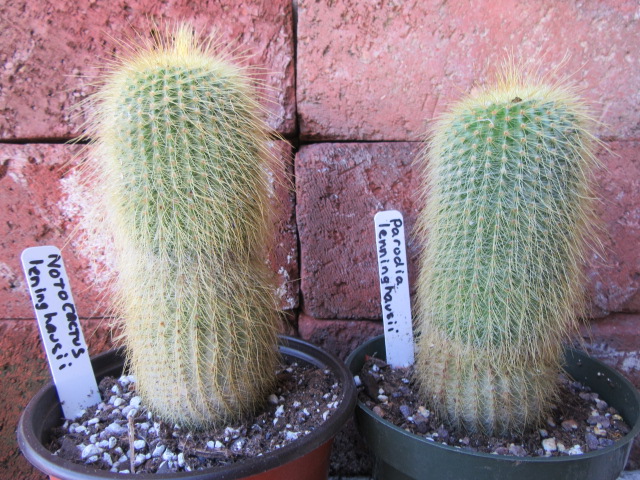
The pair of Parodia lenninghausii on 11-29-18, #534-31.
Here they are! Parodia lenninghausii the Greater (left) and Lessor (right). We have had a lot of laughs since I brought them home from Wal-Mart on February 1, 2016. First, we laughed about me bringing two of them home by accident. We have laughed about their hairdo, the confusion about their scientific name (GEEZ!), the length of time it will be until they flower, one being shorter than the other and so on. I named them Greater and Lessor and at times I forget which is which so they point to each other. That gets the rest of the cactus laughing. At one point Lessor was developing a bit of a hunch in his back but that has cleared up.
Plants of the World Online list their scientific name as Parodia lenninghausii (F.Haage) F.H.Brandt ex Eggli & Hofacker, as named and described by Urs Eggli and Andreas Hofacker in Novon in 2010. The whole story about my research on this plant’s name was very long and strangely confusing. The label with the plants said they were Notocactus leninghausii (one “n”). Pretty much EVERY website and database uses only one “n”… Except maybe Plants of the World Online and The Belmont Rooster. 🙂 I wrote a very lengthy page about this plant’s name and every time I read it I have to make sure it is accurate again. So, I stopped reading it… You know how I like going on about plant taxonomy…
To view these two plant’s own page click HERE.
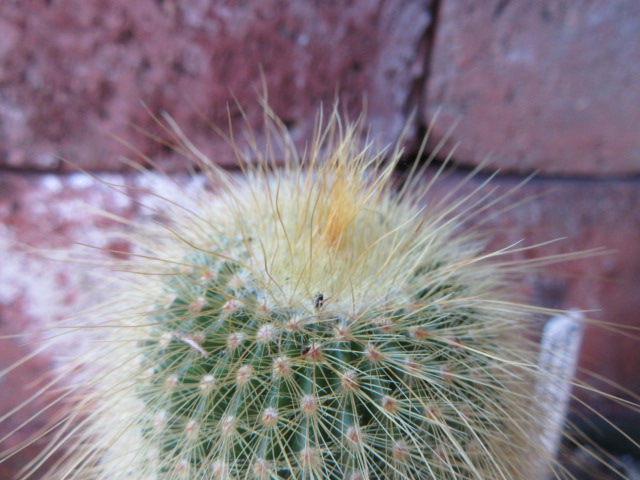
Parodia lenninghausii hairdo on 11-29-18, #534-32.
I always like their hairdo. It reminds me of Alfalfa’s hair on the old TV show called The Little Rascals (Our Gang).
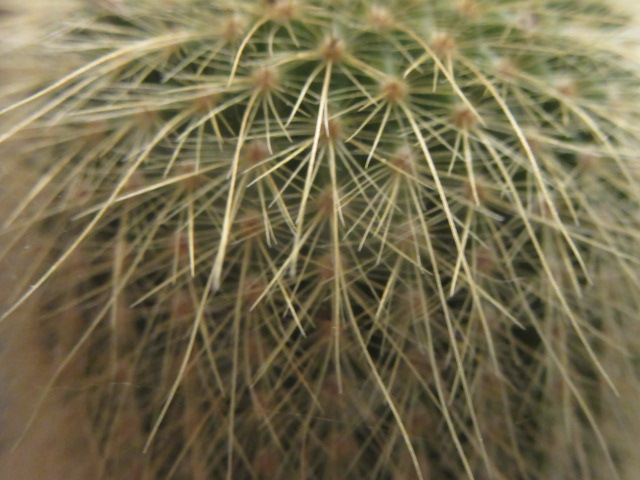
Parodia lenninghausii close-up on 12-1-18, #535-23.
Parodia lenninghausii has around 30 ribs. The areoles have both very short and thin radial spines and at least one very long central spine. The longer spines are more or less 1″ in length. The spines are not sharp at all so you can pet these guys if you want. Llifle didn’t give a spine count and I lost track trying.
This cactus will produce AWESOME yellow flowers after it is five years or so old. One time I asked them how old they were and they said, “SECRET”…
Somehow I only measured Greater on October 10 so I went to do it again… They kept jiggling around and laughing! Maybe they are ticklish! GEEZ! Anyway, Lessor measured 4 5/8″ tall x 2″ in diameter and Greater measured 4 7/8″ tall x 1 7/8” in diameter (not including their spines). Then Lessor said, “Ummm… you forgot something.” I asked what? He said, “We have angled crowns so you have to make sure you measure from the tallest side.” I said, “Oh, yeah…” So I measured them again. HOLY CRAP! They are both 4 7/8″ tall now! Maybe the Lessor was standing on his toes… Then Greater said, “He was cheating when you measured his diameter.” I said, “How could he cheat about that?” Greater said, “He was pushing out his stomach.” I said, “Then maybe you were cheating on October 10 because you were 5 1/2″ tall then. Now you are 4 7/8″ tall.” He just smiled… GEEZ! OK, so they are both around 5″ tall x around 2″ diameter. Visually, one still looks smaller than the other. Greater’s pot is slightly larger and the soil is slightly higher than Lessor’s… Nuff said…
—-<<<<+>>>>—-
Stenocereus pruinosus
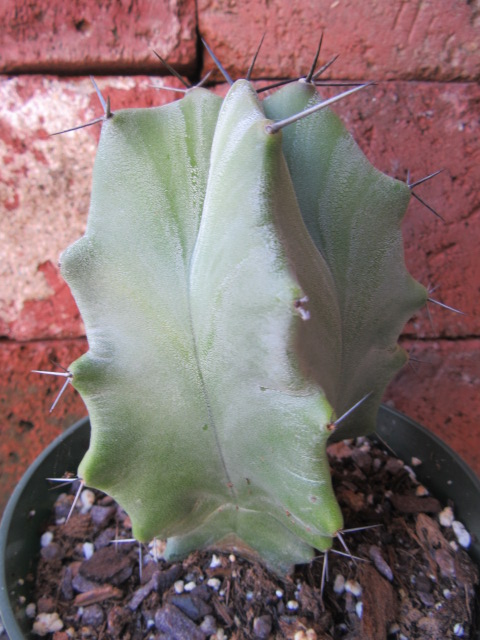
Stenocereus pruinosus on 11-29-18, #534-33.
While the Stenocereus pruinosus may look a little plain compared to the other cactus in my collection, it is still a very neat plant. I brought this plant home from Wal-Mart on February 1, 2016. We have had no surprises, no disappointments, and it doesn’t play games like the Parodia lenninghausii do. Stenocereus pruinosus (Otto ex Pfeiff.) Buxb. was described by this name by Franz Buxbaum in Botanische Studien in 1961. It was first named and described as Echinocactus pruinosus by Christoph Friedrich Otto and Louis (Ludwig) Karl George Pfeiffer in Enumeratio Diagnostica Cactearum in 1837.
You can view this plant’s own page by clicking HERE.
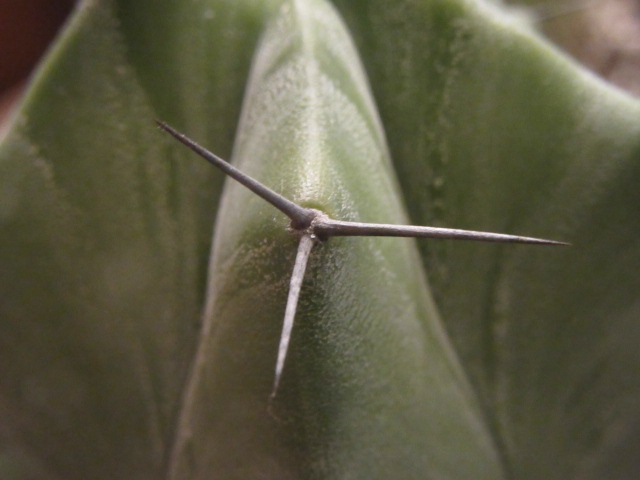
Stenocereus pruinosus close-up on 12-1-18, #535-24.
Stenocereus pruinosus is a very interesting plant for sure. Its areoles produce 1-4 short and stout central spines. Llifle also says they have 5-8 radial spines but mine has none. The Stenocereus pruinosus in my collection has five ribs but some specimens have more. They produce side branches from the base which give them a V-shaped appearance.
It measured 3 7/8″ tall x 3″ wide on October 10. It was 3 3/4″ tall last October so it only grew 1/8″ taller and 1/4″ wider this past year. It was 2 7/8” tall x 2 3/4″ wide when I brought it home.
—-<<<<+>>>>—-
Tephrocactus articulatus var. papyracanthus
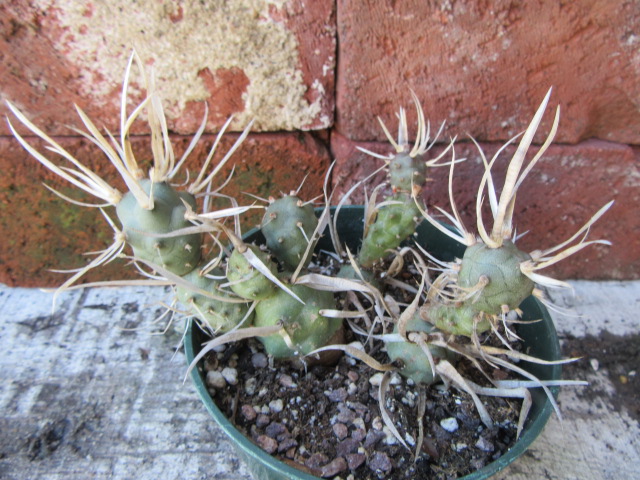
Tephrocactus articulatus var. papyracanthus on 11-29-18, #534-34.
This Tephrocactus articulatus var. papyracanthus (Paper Spine Cactus) has definitely been an interesting companion. When I was choosing cactus to bring home from Wal-Mart on February 9, 2016, a piece of one fell off so I stuck it in my pocket as a rescue. Tephrocactus articulatus var. papyracanthus (Phil.) Backeb. was first described by Carl Backeberg in the same publication as the species. It was first named and described as Opuntia papyracantha by Rudolph Amandus Philippi in Gartenflora in 1872. This is ANOTHER variety not recognized as accepted by Plants of the World Online and just say it is a synonym of the species. There are several varieties of the species all with distinguishing characteristics and all considered synonyms of the species.
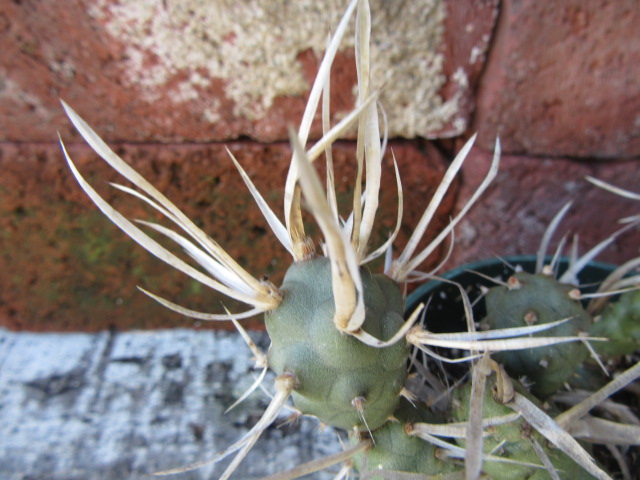
Tephrocactus articulatus var. papyracanthus spines on 11-29-18, #534-35.
The segments of this plant are loosely attached and fall off easily.
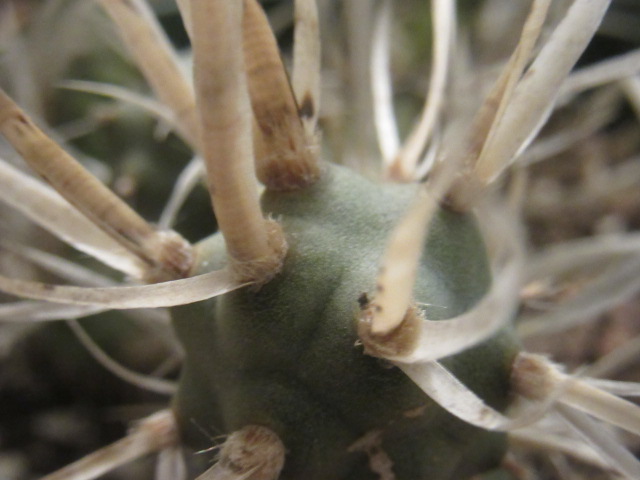
Tephrocactus articulatus var. papyracanthus close-up on 12-1-18, #535-25.
The areoles produce these strange ‘raffia-like” spines which is where the common name of this variety comes from. This plant has slightly raised tubercles but there is also a “tubercled type” of this variety whose tubercles are even more raised. This cactus areoles produce tiny glochids which differ from the wool in Mammillaria species. Glochids, which are also produced by Opuntia species (Prickly Pear) are a real pain to remove if you get them stuck in your fingers.
I think I am finally finished with this post… Now I can start reading your posts again.
Until next time, be safe, stay positive, and GET DIRTY if you can.
